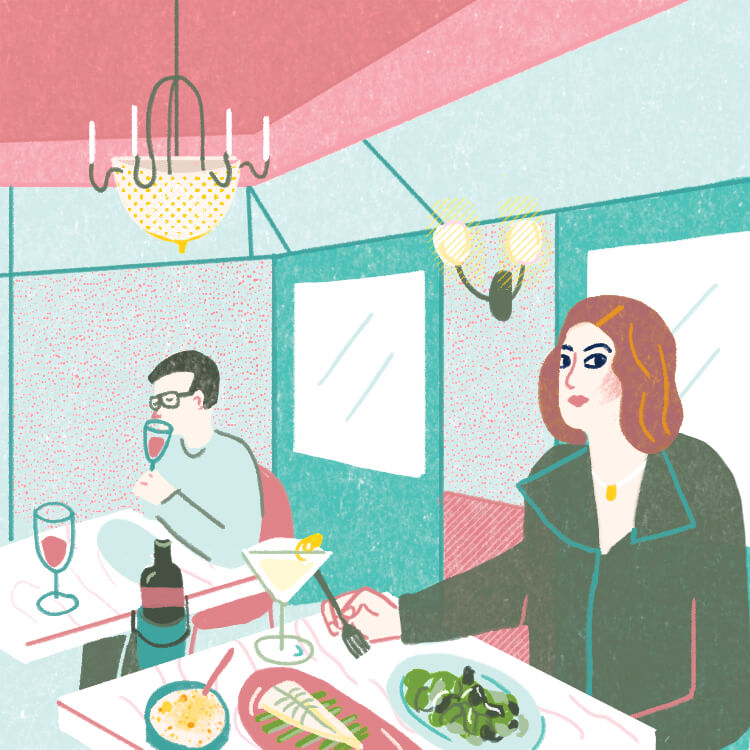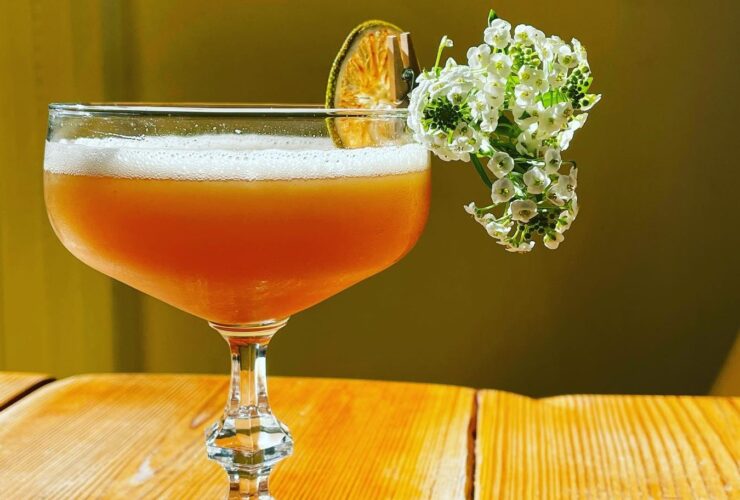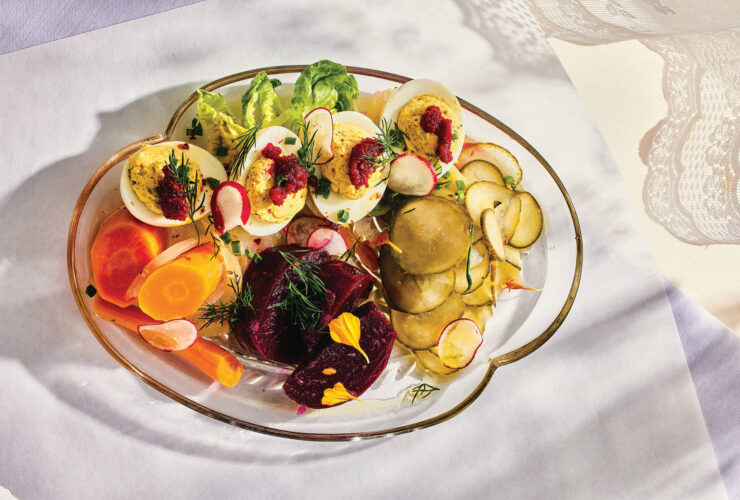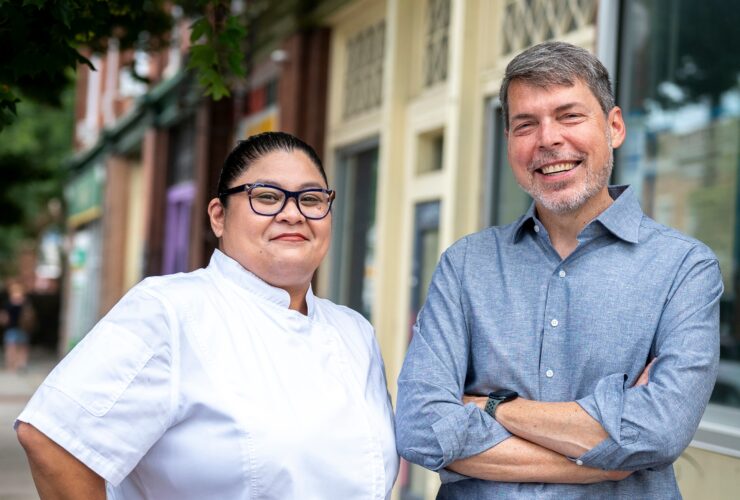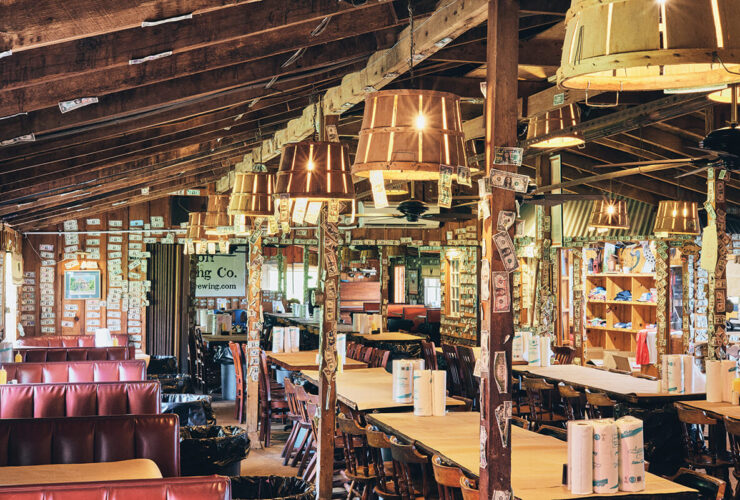
Food & Drink
Best Restaurants 2024
A paean to the places that made our mouths water this year.
Edited by Jane Marion
Written with Amy Scattergood, Mike Unger, and Lydia Woolever. Additional writing by Janelle Erlichman Diamond
Photography by Scott Suchman
Illustration by Noemi Fabra
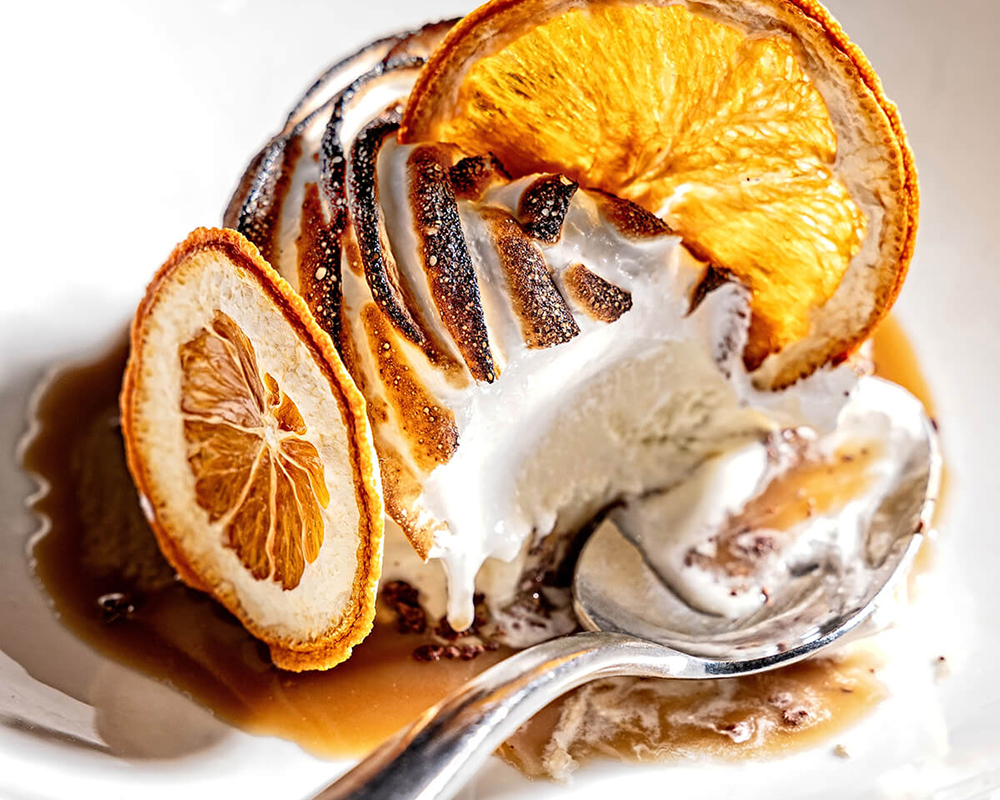

ith the fight for survival firmly in its rear-view mirror, our culinary scene has reached a new inflection point. For the past year, eating out has been an unfettered joy again. Handheld menus have returned (long live print!), service has stepped up (tip well, people!), and we avowed gastronomes can all breathe a little easier (especially without masks). The trend toward more casual dining is still holding strong, mix-and-match small plates remain de rigueur, and both the craft cocktail and the mocktail movement have left an indelible imprint on bar menus. Best of all? Chefs seem more committed than ever to honing their craft and shaping their menu missions. If we didn’t know it before, we know it now: Restaurants are more vital than ever. With so many of us working remotely or hybrid, they play a critical role in providing a place to connect, commune, and gather. In fact, at their best, restaurants are sort of accidental communities, where anyone can feel a sense of belonging and home.
Make no mistake, our city might be small, but it’s also mighty, with a restaurant scene that’s as determined, as dynamic, as delicious as any in the country. The culinary landscape continues to make its mark on the national scene, charming out-of-towners, wowing those of us who live here, and one-upping itself every year with a raft of award nominations, including James Beards—for owner-chef Chris Amendola of Foraged and Foreman Wolf’s Charleston in 2023—as well as national press, featuring Little Donna’s in The New York Times and Clavel’s Lane Harlan in Bon Appétit. This was the year that growth in the fine-dining sphere steadied, but there were some false starts and stalls for a variety of reasons, from longer-than-expected build-outs to prolonged lease negotiations. While there’s always next year, we are eagerly awaiting the reactivation of spaces like Café Hon on The Avenue in Hampden by Foreman Wolf.
That said, we still have plenty to crow about, thanks to standbys like Restaurante Tio Pepe and The Prime Rib that have been at it slowly, consistently—since time immemorial, it would seem—and a handful of newcomers, like Ammoora in Federal Hill and Bunny’s Buckets & Bubbles in Fells Point, that are welcome additions to our already vibrant scene.
Picking a best restaurant is admittedly something of a soft science, but we do our homework, studying menus, engaging with servers, and speaking with chefs about their vision. With notepads and iPhones in hand, we carefully evaluate every spot, not only for quality and execution of the food but for originality, ambiance, service, and value. We ask ourselves if the restaurant is caving to TikTok trends or turning out enduringly excellent dishes, with something novel and exciting that can’t be found on every table in town.
This year’s lineup runs the gamut from innovative, chef-driven independents like our cover model, CookHouse, in Bolton Hill, Le Comptoir du Vin in Station North, and Little Donna’s in Upper Fells, to the long-running tried-and-trues like The Helmand in Mt. Vernon and collegial Peter’s Inn in Fells Point.
As part of this list, you’ll also find a collection of deeply personal Love Letters—reflections on restaurants that hold a special spot in our hearts. While the Love Letters are all officially Best Restaurants, we’re giving them a little extra care because they remind us that the very definition of a “best restaurant” is a place that transcends the table and speaks to us on a deeper level.
As always, you’ll agree with some of our choices and debate others. But whatever the case, do get out there to revisit old favorites and make new discoveries. It’s a great time to be hungry in Baltimore.
Alma Cocina Latina
STATION NORTH
Even after a chef change and a total menu rehaul in January, the fare at this Venezuelan dining spot still thrills. Award-winning chef Héctor Romero has a particular passion for exploring the culturally diverse cuisine of his country, largely influenced by indigenous Caribbean cooking, while also incorporating ingredients from migrants who flock to Venezuela from all over the world. The dishes are a beguiling blend of citrus, spice, sweet—and often heat.
Begin your journey with an order of Iberian croquettes (topped with quince jelly) or the Nikkei crudo, a fusion of Japanese and Peruvian cuisine. This iteration highlights hamachi and tuna tartare marinating in ají amarillo-spiked tiger's milk. As for the entrees, every one is a star. Our favorites are a delicate red snapper floating in mustard seed and coconut milk sauce; and an eggplant fricassee, a vegan marvel of Indian tempura eggplant and flash-fried kale spiked with Trinidadian curry and a smoky aji dulce, plus a tangy garam masala-spiced goat yogurt served in a saucepan on the side. Combine that with the restaurant’s Instagram-worthy beauty—co-owner Irena Stein has an impeccable sense of style—and the whole experience is a culinary adventure you won’t soon forget.

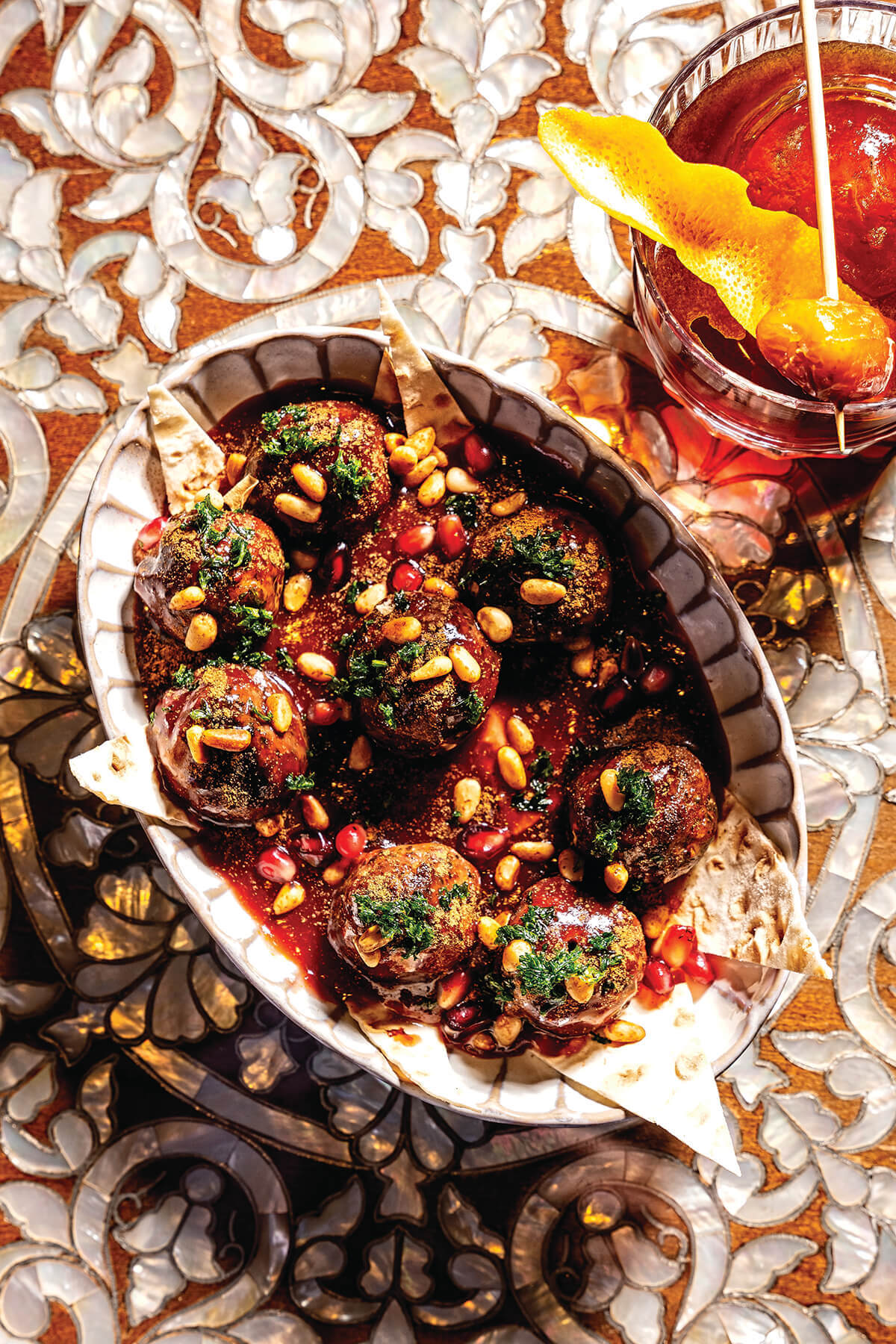

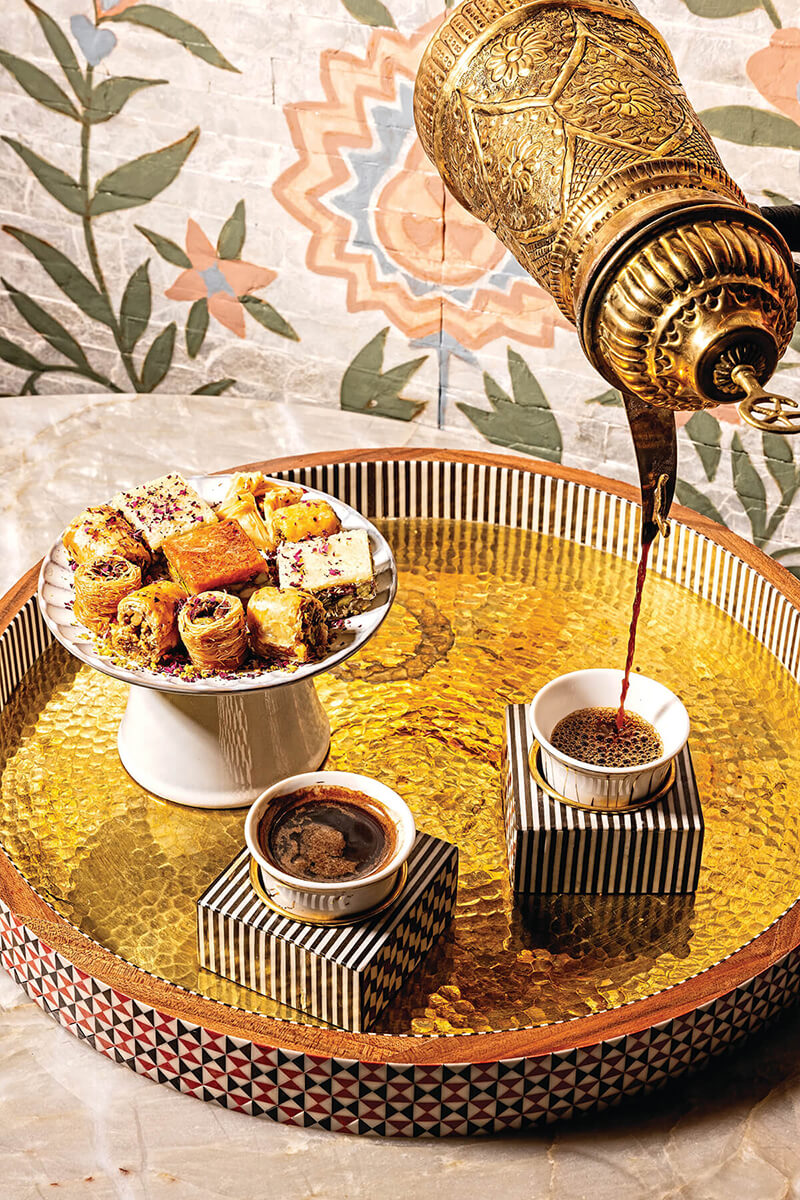
Clockwise from top: Kebbet karaz meatballs resting in a pool of sour cherry reduction; Arabic coffee service with assorted treats; with its Damascus décor, the space is positively posh.

he word “ammoora” means captivating and beautiful, which is also an apt description for the dishes that emerge from the kitchen of Baltimore’s first fine-dining Syrian restaurant. Executive chef Dima Al-Chaar’s massive menu is an ode to her native country, which allows you to pick your journey around a region that’s known for vivid flavors and bold blends of spices. Chargrilled lamb kofta gets tossed with onion and parsley, and is tinged with Turkish chile and served with a tangy cucumber yogurt dip. Tiny kebbet karaz meatballs, flecked with mint and cinnamon gremolata, float in a bath of sour cherry reduction sauce worth sopping up with cloudlike rounds of house-made pita. Even the Arabic coffee is scented with cardamom. The space, set inside the Ritz-Carlton Residences, has serious swagger, too, with mother-of-pearl-inlaid furniture and glistening Arabic coffee carts. Go with a group and book a booth tucked behind drapery and upholstered in dusty pink velvet. It’s a flavor journey that transports you straight to Damascus.
Ananda
FULTON
Open the doors to Ananda and you’ll immediately forget you’re in a Fulton development. A gowned hostess will usher you through a gorgeous restaurant filled with book-lined shelves, stained glass, and roaring fireplaces. Brothers Binda and Keir Singh have created a terrific menu of both traditional Punjabi dishes and more modern creations, from garam masala goat and chicken biryani to burrata salad with gremolata and roasted cauliflower, corn, and crab soup. Ananda has its own nearby farm, so it’s no surprise that some of the finest dishes are created from seasonal produce, each perfectly spiced, with heat calibrated to taste. Among the best on our visit: palak chaat, a bowl of impossibly crispy spinach with pomegranate seeds, tamarind chutney, and housemade yogurt; and roasted broccoli, doused with spices, house-made cheese, garlic, and more tamarind. The Singhs raise chickens and ducks for their eggs and source meats locally, with that attention to quality and detail evident on the plate. Order as many dishes as you can.
Antrim 1844 and The Smokehouse Restaurant
TANEYTOWN
Dining at this restaurant on a 19th-century estate-turned-quaint-hotel feels like being on vacation. The first part is getting there, which, unless you live in northern Carroll County, isn’t easy. But the journey is worth it. Dinner begins with hors d’oeuvres and cocktails in the cozy bar or one of several seating areas before you’re escorted to your table. A piano player often fills the multiple dining rooms with music, adding to the ambiance. On our last visit, we were handed a menu with our name printed on it, along with that of executive chef Inti Villalobos-Coady, whose six-course tasting menu offers a panoply of French-inspired cooking.
There are options for each course, and we started with grilled octopus with couscous, fava beans, sweet corn, and shishito peppers, which added a nice element of heat. Our main dish, an excellent pan-seared halibut, was presented in a mushroom and dashi broth with cipollini onions and foraged mushrooms. Preparing a classic fish like this is a risk, but Villalobos-Coady is more than up to the task—the dish is a marvel. Meals here are not to be rushed, and many couples linger over bites of crème brûlée or a rich cheese plate for dessert. An after-dinner cappuccino—or better yet a cognac—is a perfect cap to a meal that feels like an escape from the monotony of everyday life. Perhaps next time we’ll get a room and stay the night.
Ash Bar
MT. VERNON
From the dimly lit, red-hued dining room to the snake-themed dishware and naughty-but-nice café society vibe, Ash Bar is a true Baltimore original (the same can be said of the Ulysses hotel in which the restaurant resides). But style only goes so far without substance. Here, the menu—overseen by Lauren Sandler, formerly of Woodberry Kitchen—features mostly elevated bistro fare, including a delicate pan-roasted salmon with celery root velouté, a comforting rigatoni Bolognese, and a classic roast chicken with tomatoes. Some offerings do shift with the seasons, but there are signature staples like the 24-hour pressed potatoes with sour cream and trout roe (think blinis) that you should order no matter how often you go. The preparations are solid and at a price point that won’t break the bank. If you want to extend that festive feeling, begin (or end) your night at the Bloom’s bar just down the hallway, which looks like something straight out of a David Lynch film, or stroll around the corner of the hotel to grab a potent craft cocktail from The Coral Wig, the latest creation from Clavel’s Lane Harlan.
Azumi
HARBOR EAST
There are few things as much fun as eating sushi on the Baltimore waterfront, chopsticking up perfectly cut hirame, ikura, and toro as the sun sets behind the Domino Sugars sign. This experience is brought to you by Azumi, located on the ground floor of the Four Seasons Hotel, featuring an omakase menu and fish flown in daily from Tokyo’s famed Toyosu Market. In addition to a stellar list of seafood for that sushi, which includes specialties like truffle uni and A5 Miyazaki Wagyu beef with foie gras, there are also various showy rolls, tempura, and barbecue-style robata, as well as bigger dishes, of which the miso black cod is particularly good. It’s worth noting that the nigiri is divine but smaller than average. (The upside is that this delivers the full flavor in one bite.) If you’re feeling flush, splurge on the Emperor’s Sushi Feast, consisting of 40 pieces of fresh fish for $240. And then maybe order another Serenity sake cocktail with the bill to ease the sticker shock.

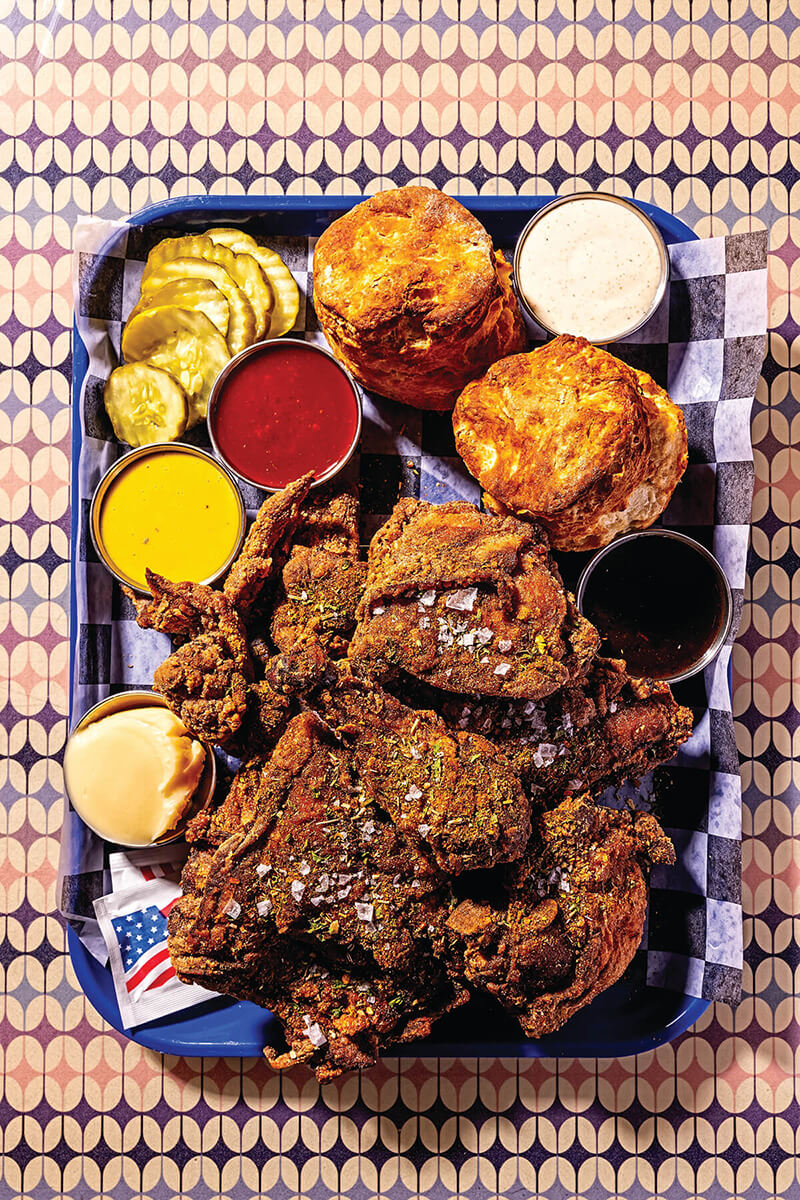
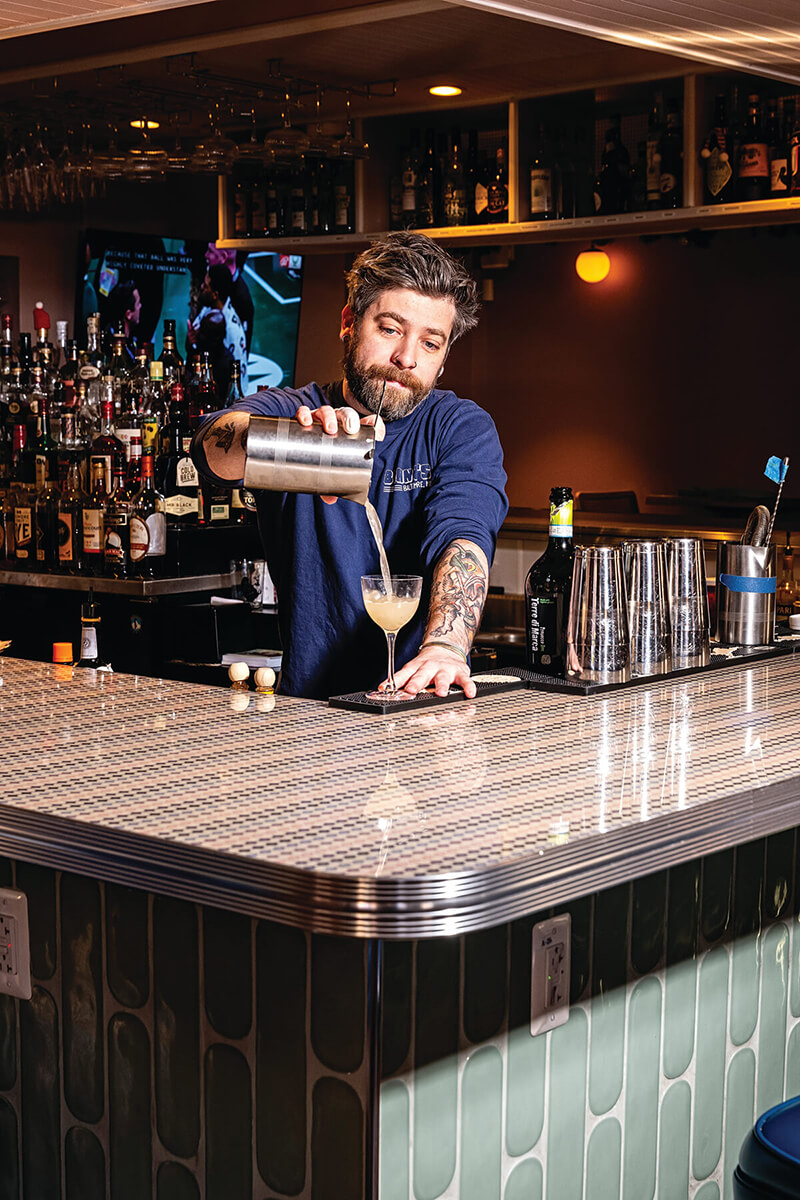
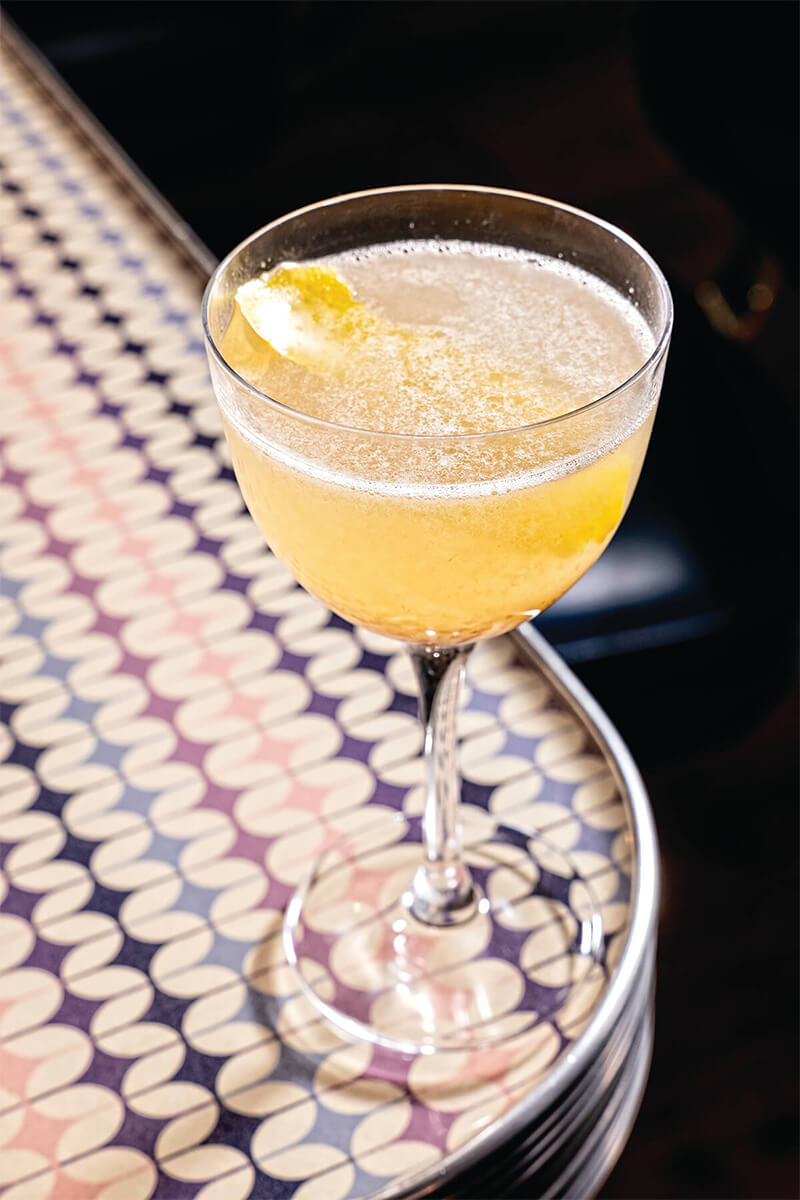
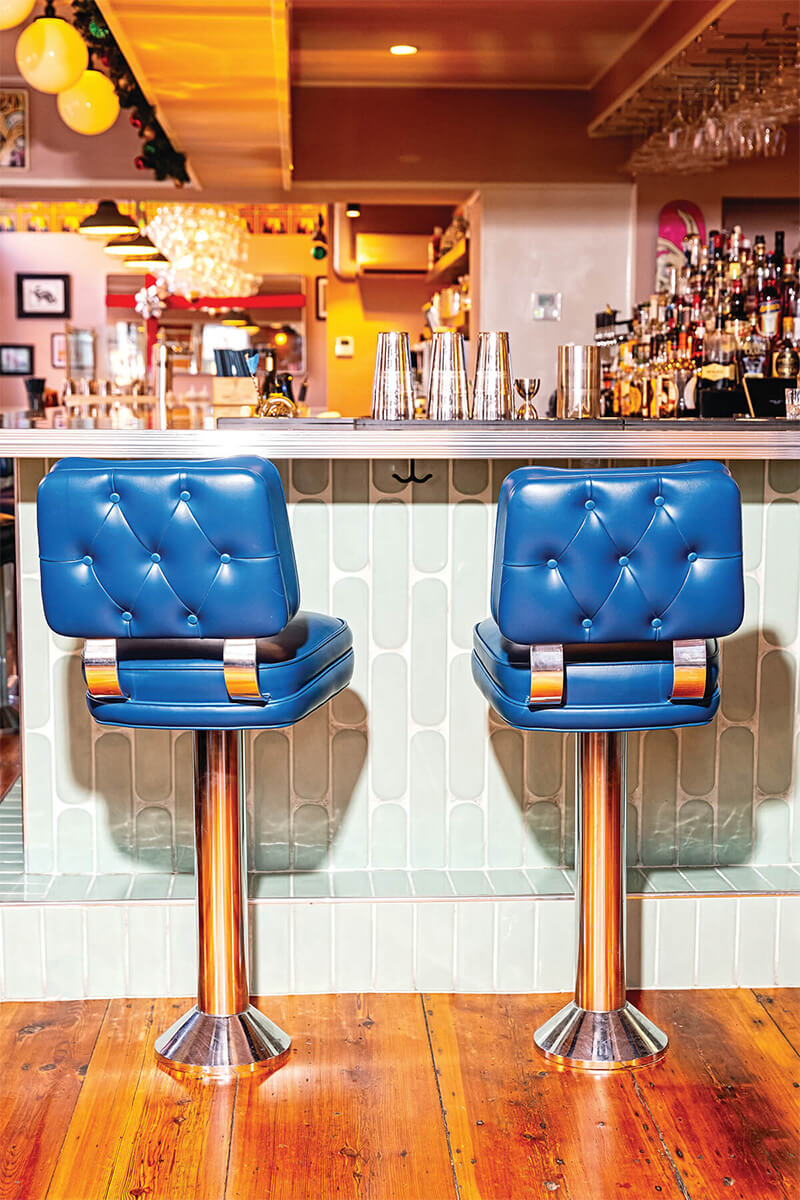
Clockwise from top: Sandlin’s signature fried chicken and biscuits with pickles; a pear and Prosecco cocktail; the whimsical décor; pouring a drink.

The bunny-themed bathroom.
It takes a unique talent to transform a former neighborhood watering hole into a white-hot dining destination, but that’s exactly what Top Chef alum Jesse Sandlin has done with her latest concept, on the site of the former Wharf Rat in Fells Point. With its pink walls, rabbit-themed art, and bodacious bubble chandeliers, the place is pure whimsy. The fun also translates to the food—Sandlin’s decadent menu is built around the namesake buckets of audibly crisp fried chicken (plus divinely flaky biscuits) and perfectly paired bottles of Champagne. (Fun fact: The acidity of the bubbles cuts the fat from the chicken.) And while the offerings can best be described as casual, quirky, and Southern-accented—fancy deviled eggs, pimento cheese croquettes, fried oyster po’ boys—there’s a slate of wonderful chef-driven dishes, too, that show off Sandlin’s skills. The shrimp and grits, smothered in shrimp cream and a fantastically flavorful rendition of the Low Country standard, is coastal comfort food at its best.
Charleston
HARBOR EAST
While perfection is nearly impossible to achieve in any pursuit (let alone the restaurant business), this paragon of white-tablecloth dining comes close. After 26 years, co-owners Tony Foreman and Cindy Wolf still hit it out of the park night after night, sustaining a level of attention to detail that’s worthy of the highest gastronomic honors. There’s a reason why Wolf has been nominated for James Beard Best Chef Mid-Atlantic many times over. (Though we’re baffled by the Beard folks who never actually bestow her with the medal.) Inspired by her frequent culinary travels to Michelin-starred spots in France, the chef works tirelessly to tantalize our tastebuds—and all her plates are an archetype of artistry. A single sea scallop sautéed in lemon brown butter sits on a throne of cauliflower purée ringed by tiny capers on one iteration of the menu; pan-roasted magret of duck is partnered with a sunset-colored strawberry-rhubarb compote on another.
The front of the house is flawless, too; oenophile Foreman, along with genial maître d’hotel Peter Keck, keep things running with military precision, and not a fork is out of place. The positively splendid dining rooms—a series of three spaces, plus the bar, are exquisitely tasteful, each with its own personality, which means that no two visits are ever the same. Need a second opinion? While the ever-evolving tasting menu offers a three-to-six course option, last summer, one patron ordered a whopping 11 dishes, and that’s not even the restaurant record of 13. (Basically, one of everything.) Can’t say we blame them.
The Choptank
ANNAPOLIS
It would be hard to find a more apropos setting in which to slurp oysters, crack crabs, or indulge in the other bounties of the Chesapeake Bay than this second location of the Atlas Restaurant Group’s upscale Maryland seafood house concept. But setting alone—though it’s hard to beat this one, which overlooks the capital city’s famed Ego Alley—does not produce a top-notch restaurant. The food here speaks for itself. Rockfish ceviche features thick pieces of fish, thin slices of cucumber, and chopped tomatoes, onions, and jalapeños. The freshness of each component is evident. Steaks, strips, and sandwiches are available, but you come here for the cornucopia of fish and shellfish that can be seared, broiled, or blackened. On a recent visit, we opted for scallops with a side of amazingly rich ponzu-shiitake brown butter. In the warmer months, it can be a struggle to get a reservation, so plan accordingly. Once you’re here, you’ll see—and taste—why.
Cinghiale
HARBOR EAST
Seldom does a restaurant do so many things so well. At Cinghiale, Tony Foreman and Cindy Wolf’s beautiful Harbor East enoteca and osteria, dinner starts with a worldclass selection of imported cheeses and meats. Antipasti include foie gras, roasted pumpkin soup, and a terrific bluefin tuna crudo with avocados, cucumber, capers, and chile oil. Be sure to order at least one of the outstanding house-made pastas, which come in every conceivable shape and size. (They’re available in full and half portions.) The mushroom lasagna, with roasted eggplant and garlic fonduta, is delightfully rich. Our server heard us mention that we planned to share it and thoughtfully split the order on two plates.
Mains include meats like roasted venison, which is lean and tasty, with sweet potatoes and mustard greens. Veal, duck, chicken, and fish are all complemented rather than overshadowed by the methods in which they’re prepared. (The grilled swordfish, in a hazelnut-anchovy brown-butter sauce, is the perfect example of this synchronicity.) With an impressive multipage wine list—and a sommelier on hand for advice—Cinghiale has every angle covered.

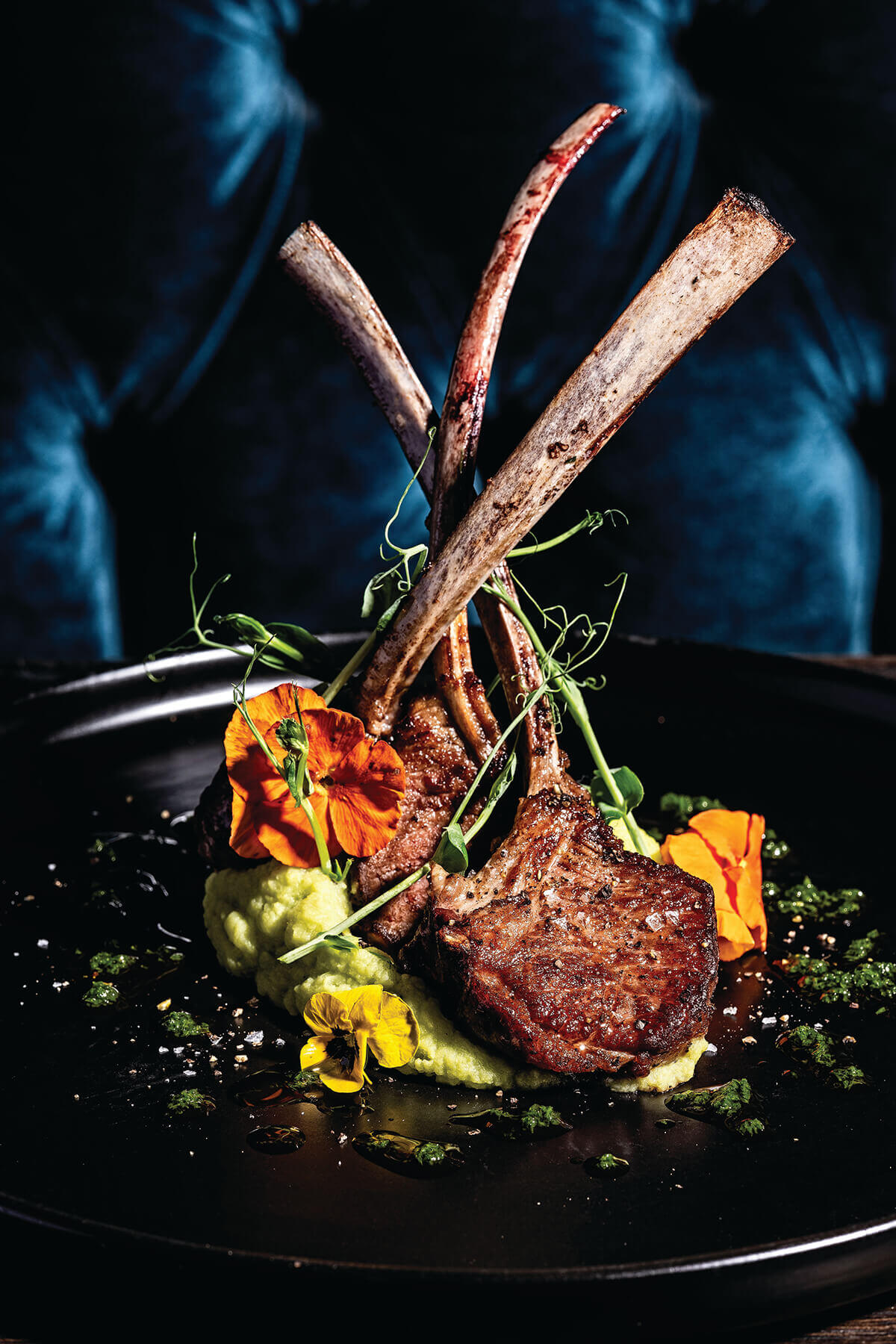
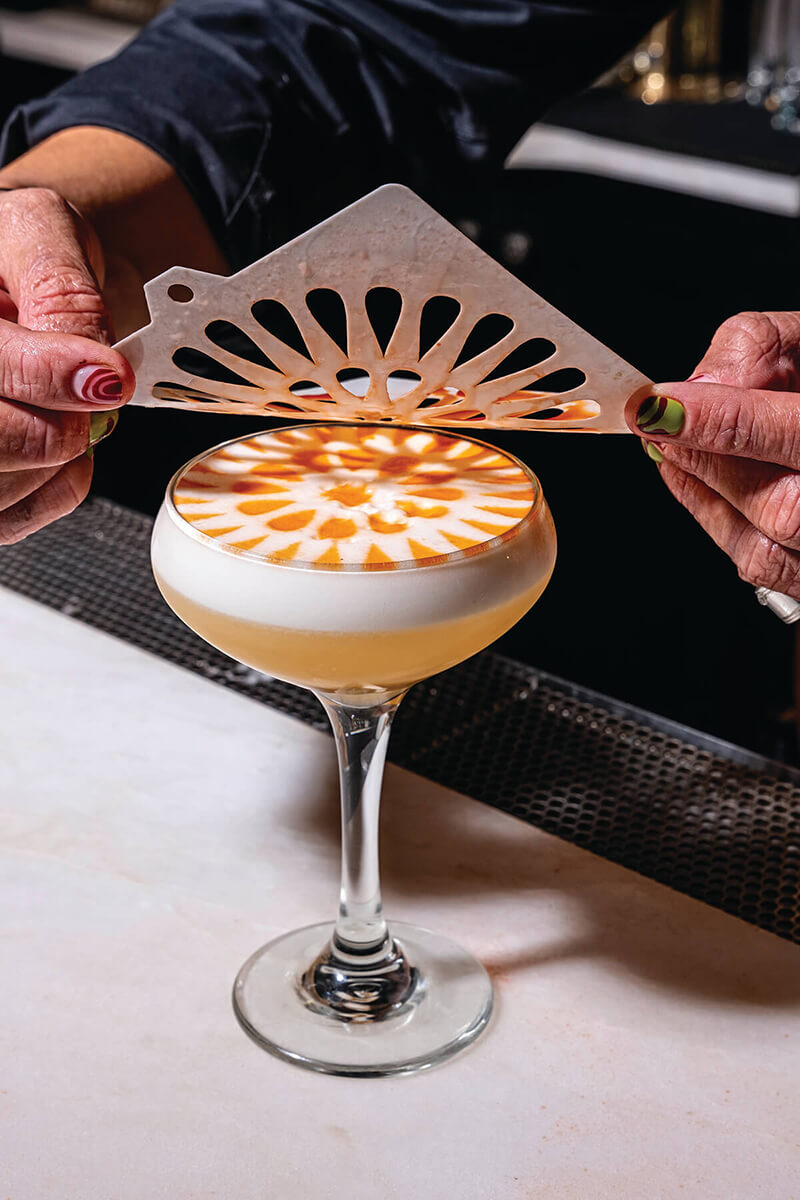
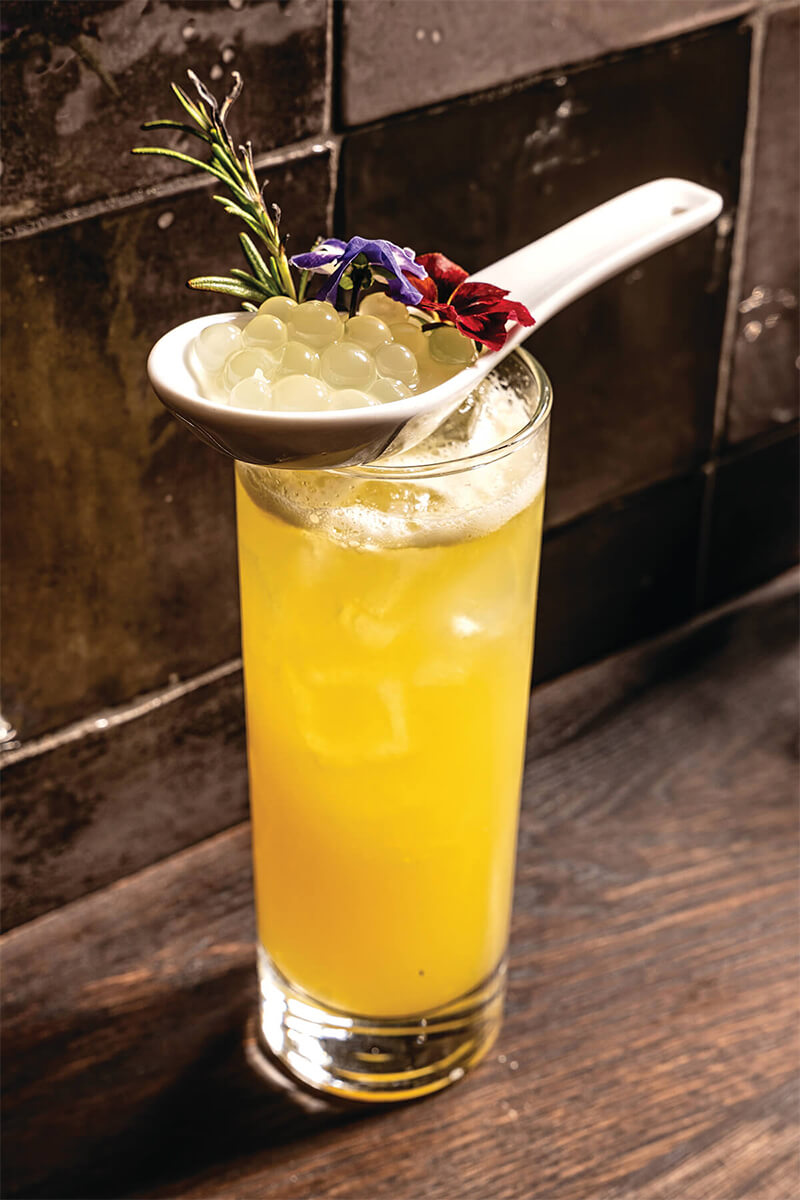
Clockwise from top: Lamb chops with English peas and mashed potatoes; the Cilantro cocktail; The Honey, I’m Foam cocktail.
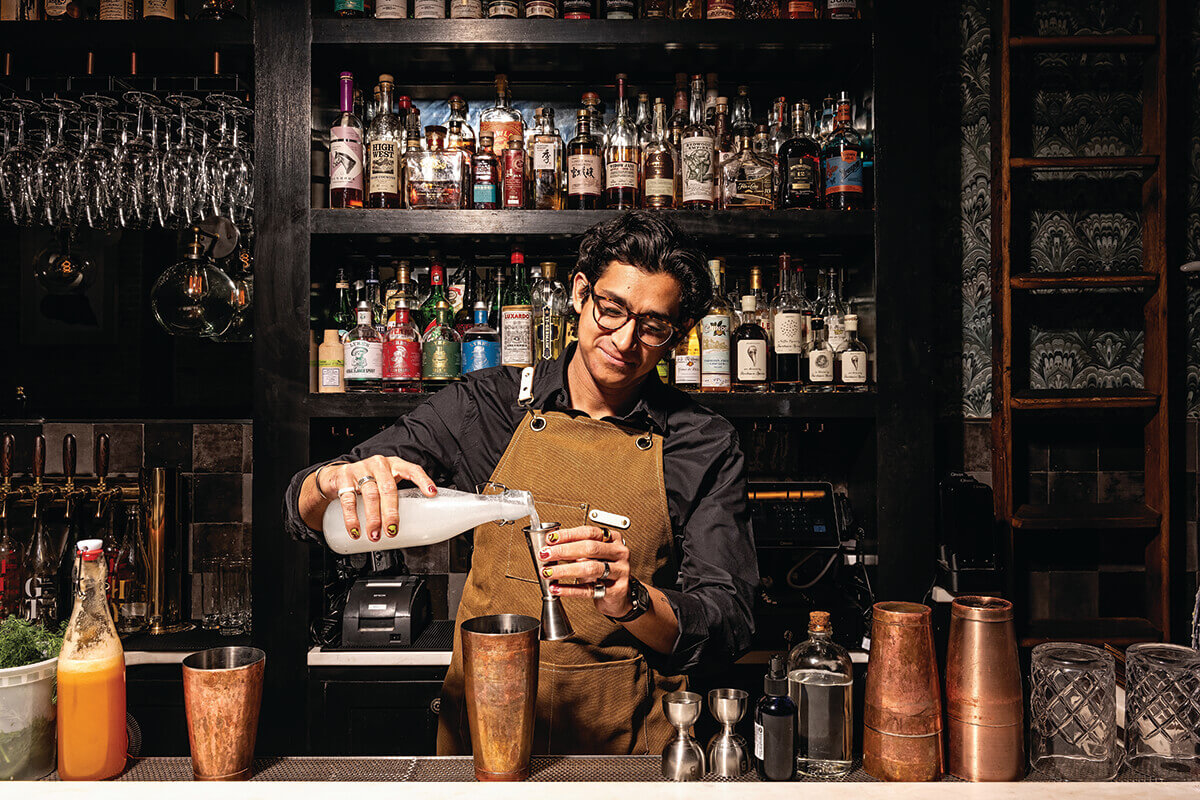
Bar director Gabriel Valladares at work.

hortly before 6 p.m. a line forms around the block outside this brownstone bistro, which doesn’t take reservations. When the doors officially open, customers are quickly seated inside the intimate but charming dining room, or at the smallish but lovely bar. What comes next—intricately made, inventive cocktails and spectacular dishes—explains the place’s popularity. Bar director Gabriel Valladares is among the most talented mixologists in the city, and his drinks are as artful as they are tasty. The food side, thoughtfully conceived and expertly prepared by chef-owner George Dailey, is equally impressive. Starters like panko-encrusted chèvre baked in a smoky tomato sauce and a grilled octopus tentacle in a tomato-based romesco sauce are wildly inventive. The steak frites ($10 off on Wednesdays) are always a crowd favorite, but we found even more joy in the vegan “scallop” curry, made with king oyster mushrooms and a Thai coconut curry dotted with peanuts. It’s a sterling example of Dailey’s creativity and attention to detail, traits that make CookHouse worth the wait, however long the line may be.
Dok Khao Thai Eatery
COLUMBIA
Don’t let the outdoor mall near the Merriweather Post Pavilion discourage you—Porntipa Pattanamekar’s Columbia restaurant is a bustling gem of a place. There’s a salmon-colored chaise lounge in the foyer for those waiting for a table (no reservations) and a working fountain in the center of the large, inevitably crowded dining room. Plants and birdcages decorate the restaurant—even the chandeliers are enclosed by birdcages—and the whole place evokes a dream-like garden shop.
The large menu is loaded with Thai favorites: The curries are excellent, with spice adjusted to taste, and there are exemplary versions of expected dishes (pad Thai, tom yum soup, drunken noodles) plus specialties like lychee duck curry, lamb massaman curry, and “cry baby noodles,” an addictive sweet-and-sour concoction. Especially on the weekend, Dok Khao can get very busy, but don’t be put off by those large crowds—the service is spectacular, with attentive waiters and dishes appearing as if by magic. There’s also a surprisingly large dessert menu that includes mouth-watering mango parfaits and a Thai tea crème brûlée.
Duck Duck Goose
FELLS POINT
The name might conjure memories of a children’s game, but the fare at Ashish Alfred’s outstanding French restaurant is geared toward the most mature of palates. That said, despite the elevated food, Alfred knows his restaurant sits in a neighborhood known more for partying than pâté, so it’s unpretentious and approachable. Start with a Duck L’Orange cocktail, which he swirls with duckfat-washed Sagamore Rye and gooseberries, cardamom bitters, star anise, and cinnamon. It’s a wonderful drink that sets the stage for the food. Classic Parisian appetizers like escargot and duck liver pâté are excellent, as is the roasted cauliflower, which is brilliantly paired with a date purée. As one might expect, the namesake duck is represented heavily among the entrees (the roasted duck breast is rich and tender), but much else shines as well. If there’s a better place to get coq au vin in the city, we’ve yet to find it. Dessert is not to be overlooked here, and the croissant bread pudding, topped with caramel, is lighter than most but no less delectable. It’s fun and French—a combination Duck Duck Goose has nailed.
Foraged
STATION NORTH
Stew in summer? It’s not the first dish that comes to mind in that season, but Chris Amendola has never been satisfied with the status quo. His menu is ever-changing—sometimes even daily, as a dish might be served with a different kind of pasta or variety of tomato on any given night. But the chef always stays true to his ideals: using the freshest, most local ingredients possible (including, as the name would suggest, some that he forages himself) in creative ways. Take that stew, for example, which is a signature menu item on most visits. It is mushroom-based, and includes ricotta, herbs, pine nuts, and a poached egg. The result is a burst of umami that hits the spot any time of year.
On one recent visit, the seasonal offering of lightly fried squash blossoms stuffed with cheese reminded us of elevated jalapeño poppers; on another, a clever Maryland-style mushroom “crab cake” mimicked our state seafood. And while vegetables really shine here, the kitchen treats meat with similar respect. Take, for example, another offering—a leg of lamb topped with zesty chimichurri served over eggplant purée with roasted tomato and broccoli. As with so many of the dishes here, it was a perfect melding of ingredients and offers an apt demonstration of why Amendola was named a James Beard Award semifinalist in the Best Chef: Mid-Atlantic category last year.
Gertrude’s Chesapeake Kitchen
HOPKINS-HOMEWOOD
Renowned chef-owner John Shields opened this quintessential Bay-to-table restaurant inside the Baltimore Museum of Art in 1998 and, a quarter-century later, it hasn’t deviated from its mission. The menu still highlights the bounty of the Chesapeake in dishes like Chincoteague fried oysters, smoked blue catfish catties, and rockfish imperial accompanied by creamy garlic mashed potatoes that makes a wonderfully rich dish combining the best of land and sea. Shields also excels with less traditional dishes like pleasingly spicy udon noodles tossed in a soy sauce, chile oil, orange zest, and toasted sesame seeds, while lamb meatballs with figs and yogurt sauce are worthy of their menu moniker “Greektown.” Gertrude’s wouldn’t have thrived for 25 years if its chef-owner had rested on his laurels. Thankfully, he hasn’t. And bonus points to Shields for being one of the most congenial chefs in town.

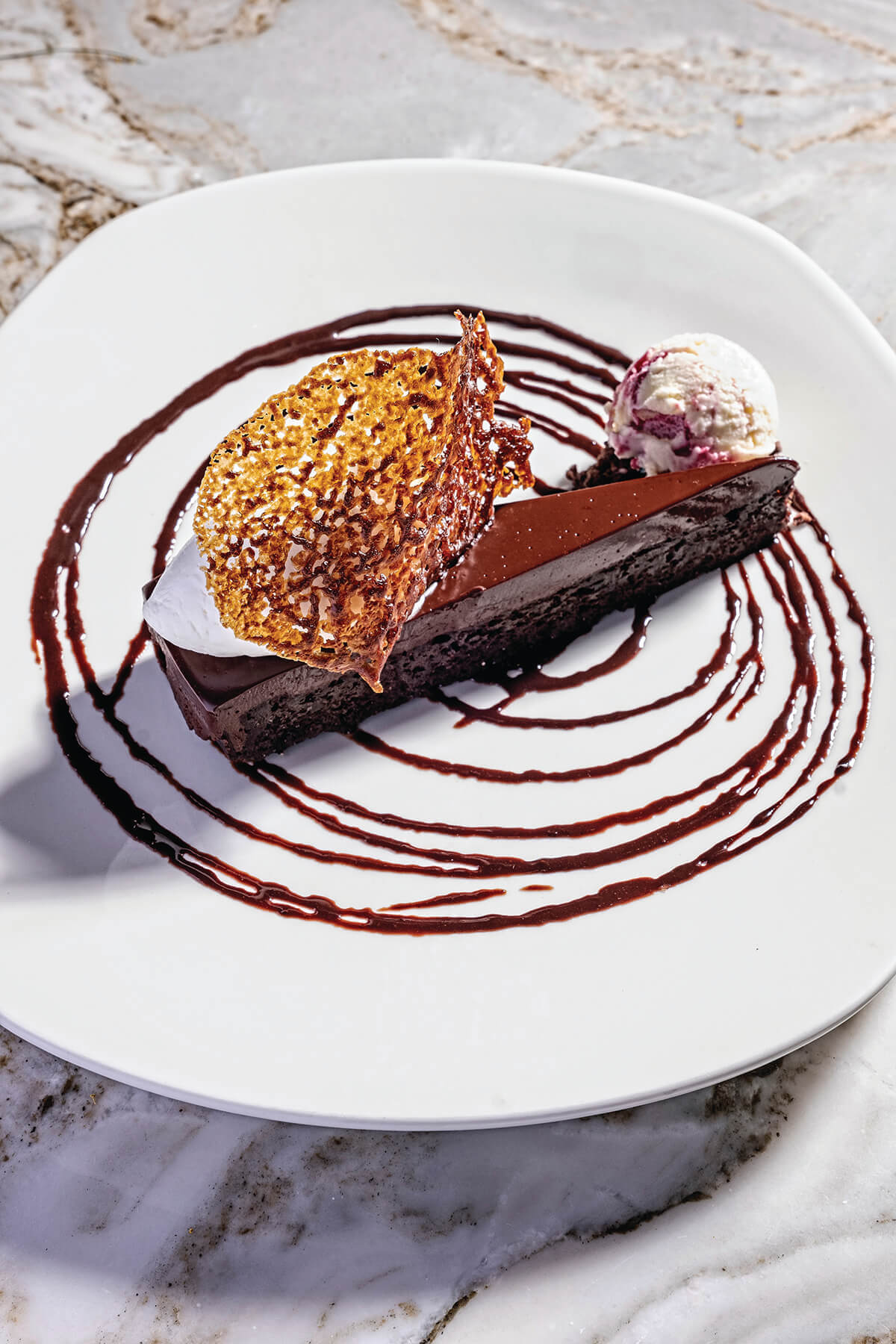
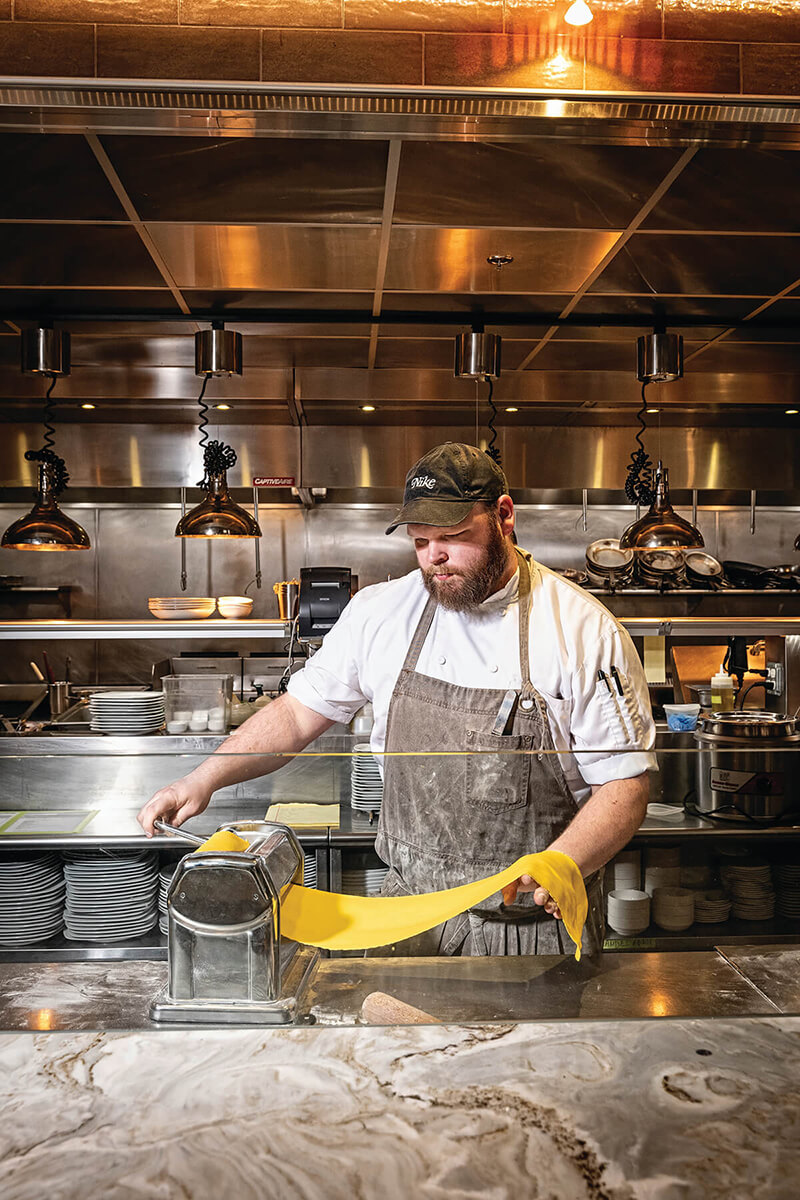
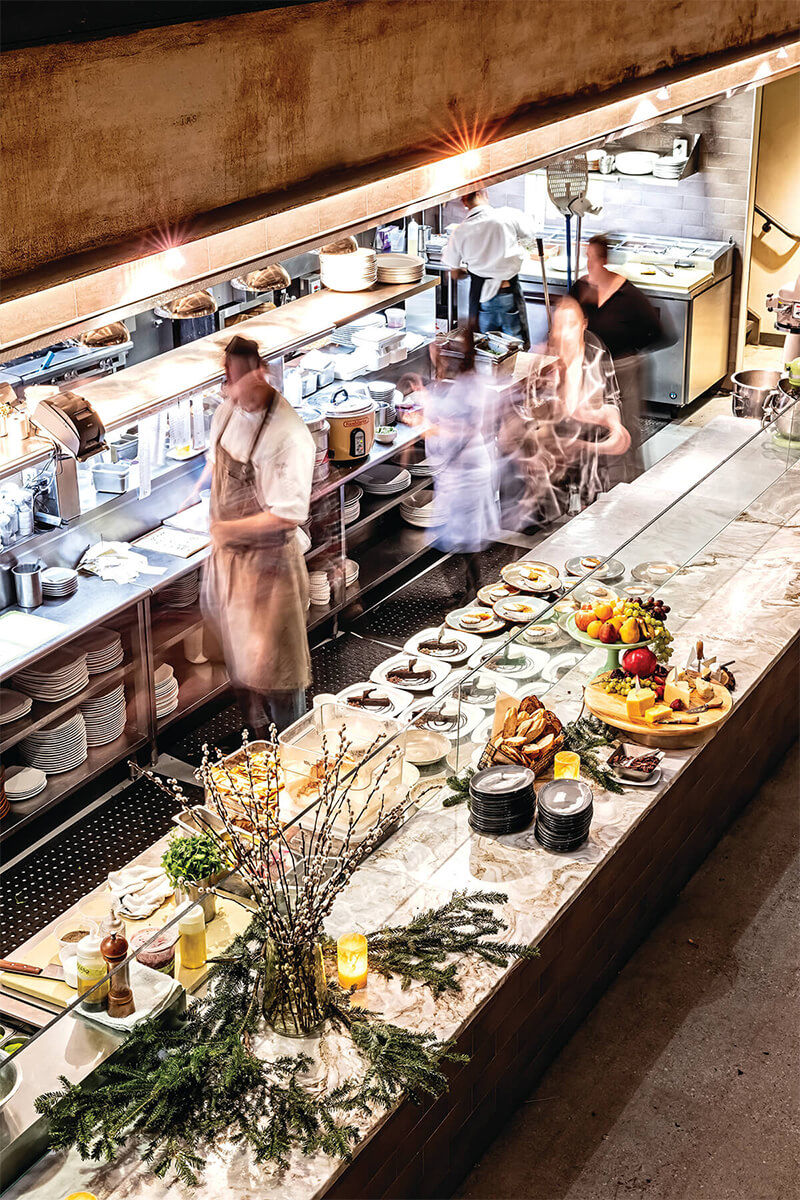
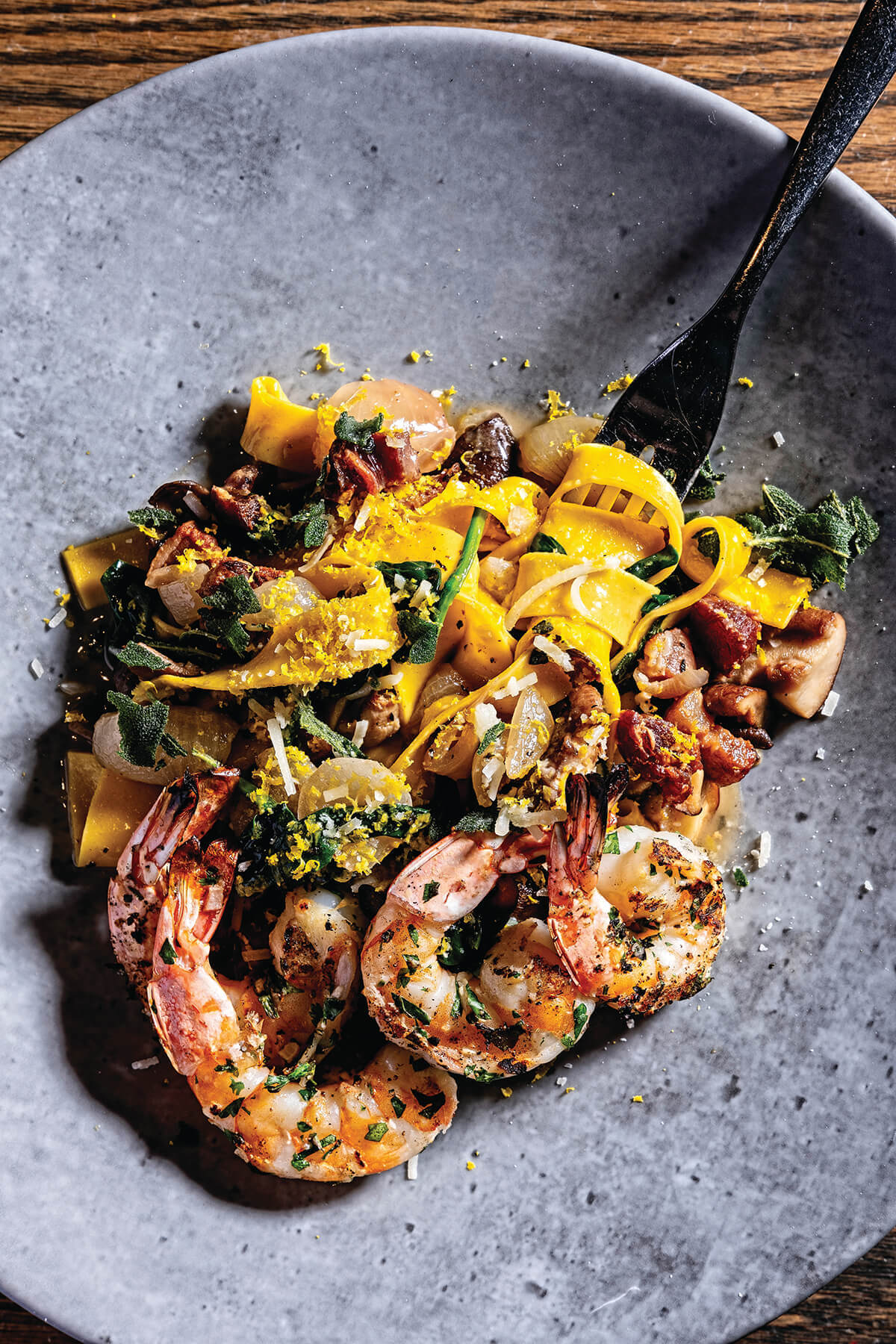
From top: Chocolate pavé; preparing food on the line during dinner service; making sheets of pasta; the house-made tagliatelle with shrimp.

The living wall in the dining room
Even after nearly a decade, this Brewers Hill restaurant in the century-old boiler room of the Gunther Brewing Company continues to dazzle diners. For starters, there’s the always amiable Director of Operations Nancy Hart Trice, who sets the tone with her warm hospitality. And then there’s her husband, chef Jerry Trice, who meticulously sources the very freshest local ingredients and draws inspiration from around the world to make them shine.
The hits keep coming. A cavalcade of appetizers—from a colorful kale and greens salad with pickled onions to the green garbanzo hummus with flatbread to a refreshing halibut crudo scattered with slices of avocado sitting in a puddle of coconut milk and charred habanero oil—are edible masterpieces. The signature Thai seafood hot pot—clams, mussels, shrimp, and pieces of white fish floating in a dizzyingly delicious curry and topped with a hill of cilantro—brims with fragrant flavor. Desserts, an afterthought on many a menu, are the pièce de résistance here, thanks to pastry chef Jessica Banner. Consider whatever is in season, whether that means a chocolate pavé or Black Forest pavlova. (She also bakes the homemade Parker rolls, a New England classic.) Also of note: There’s not a bad seat in the house here. Sidle up to the open kitchen and watch the show unfold—or sit on the gorgeous patio and count your lucky stars for great food in a beautiful setting.
The Helmand
MT. VERNON
There’s little need to change much of anything at a restaurant like The Helmand. For more than three decades, gracious owners Pat and Qayum Karzai have quietly led the fine-dining scene in the city. The kitchen of this Baltimore culinary linchpin has produced a kaleidoscope of flavors that wows both newcomers and customers who have been coming since day one. Everyone knows that The Helmand’s renowned kaddo borwani—pan-fried and baked baby pumpkin seasoned with sugar and served on yogurt garlic sauce—is a must-order. But the menu, exotic yet approachable, is filled with other items to tempt you, like the zardalu challow—chunks of lamb simmered with sun-dried apricots, prunes, tomatoes, garlic, turmeric, and chile peppers—or the mourgh challow: chicken sautéed in yellow split peas and tomatoes. Every time we return, which is often, we’re thrilled that it’s just as we remembered.
Hersh’s
RIVERSIDE
Drive to the southernmost end of Light Street in South Baltimore and you’ll find one of the city’s best pizzerias in a big brick building on the corner that once housed a barbecue joint. Owned and operated by the Hershkovitz siblings, Stephanie and Josh, Hersh’s is strung with Edison bulbs and seems to be guided by the heat and principle of the 5,000-pound, Italian-made, wood-burning pizza oven that the pair forklifted into the space. The Neapolitan-style pies that emerge from this behemoth are spectacular: a margherita with house-made mozzarella, a version of Frank Pepe’s classic New Haven clam pie, and a white pizza with pistachios and kale that keeps regulars coming back. The pasta, also made in-house, is excellent as well: a short list of cavatelli or tagliolini, each perfectly tricked out. In short, Hersh’s has everything a pizzeria should have—great pies—plus everything most pizzerias do not, including rustic entrees (a satisfying swordfish over couscous) and deft appetizers (wood-fired octopus) that you’d expect to find at a white-tablecloth spot.

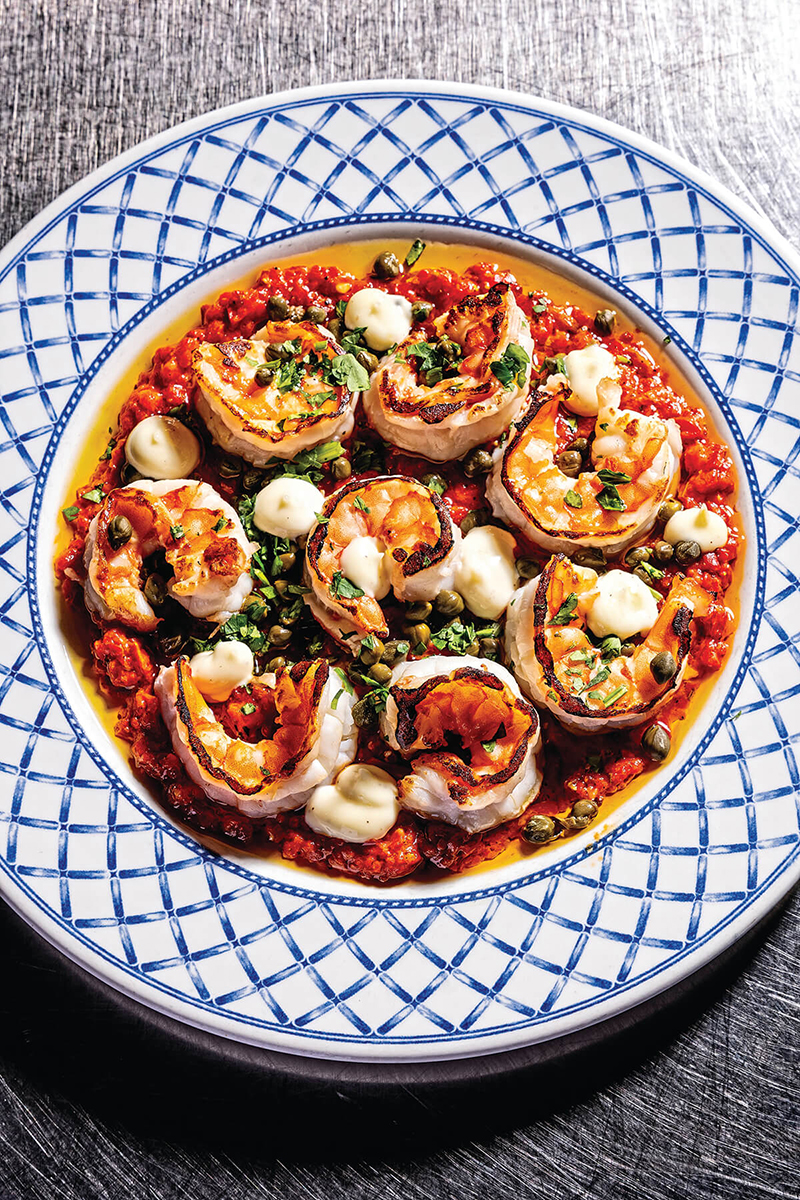
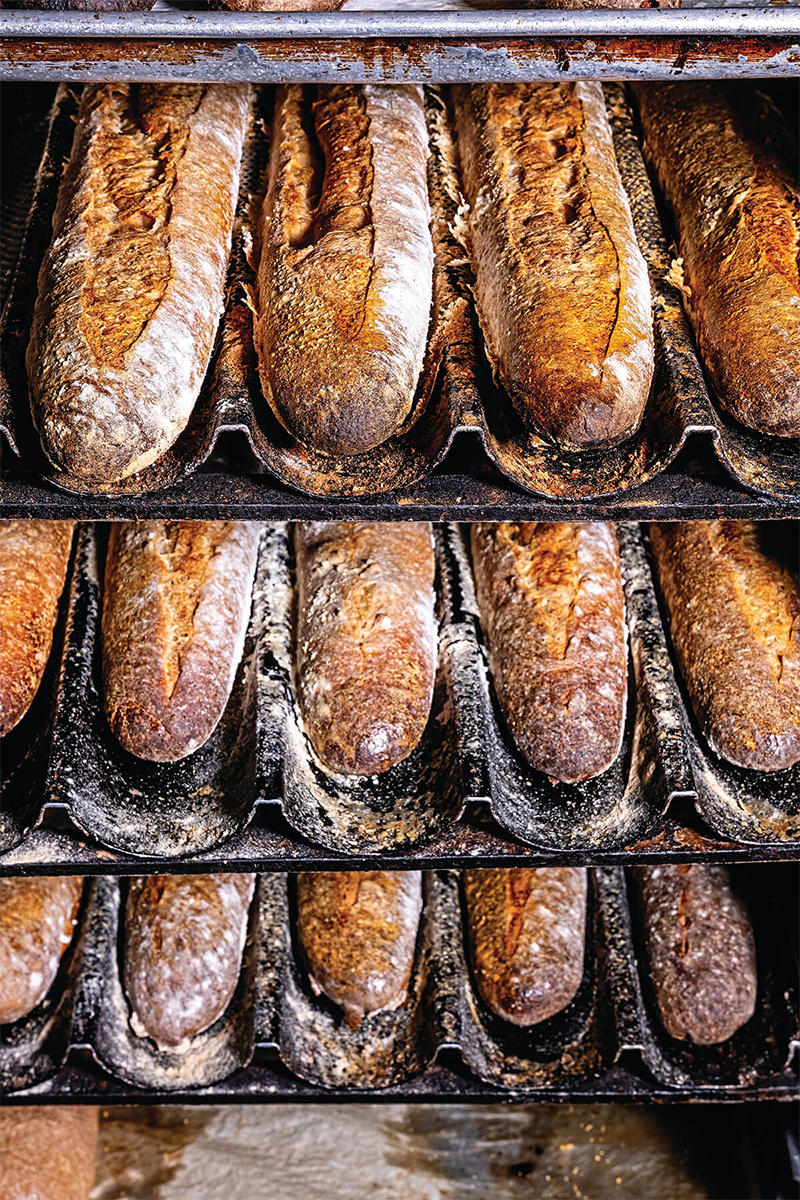
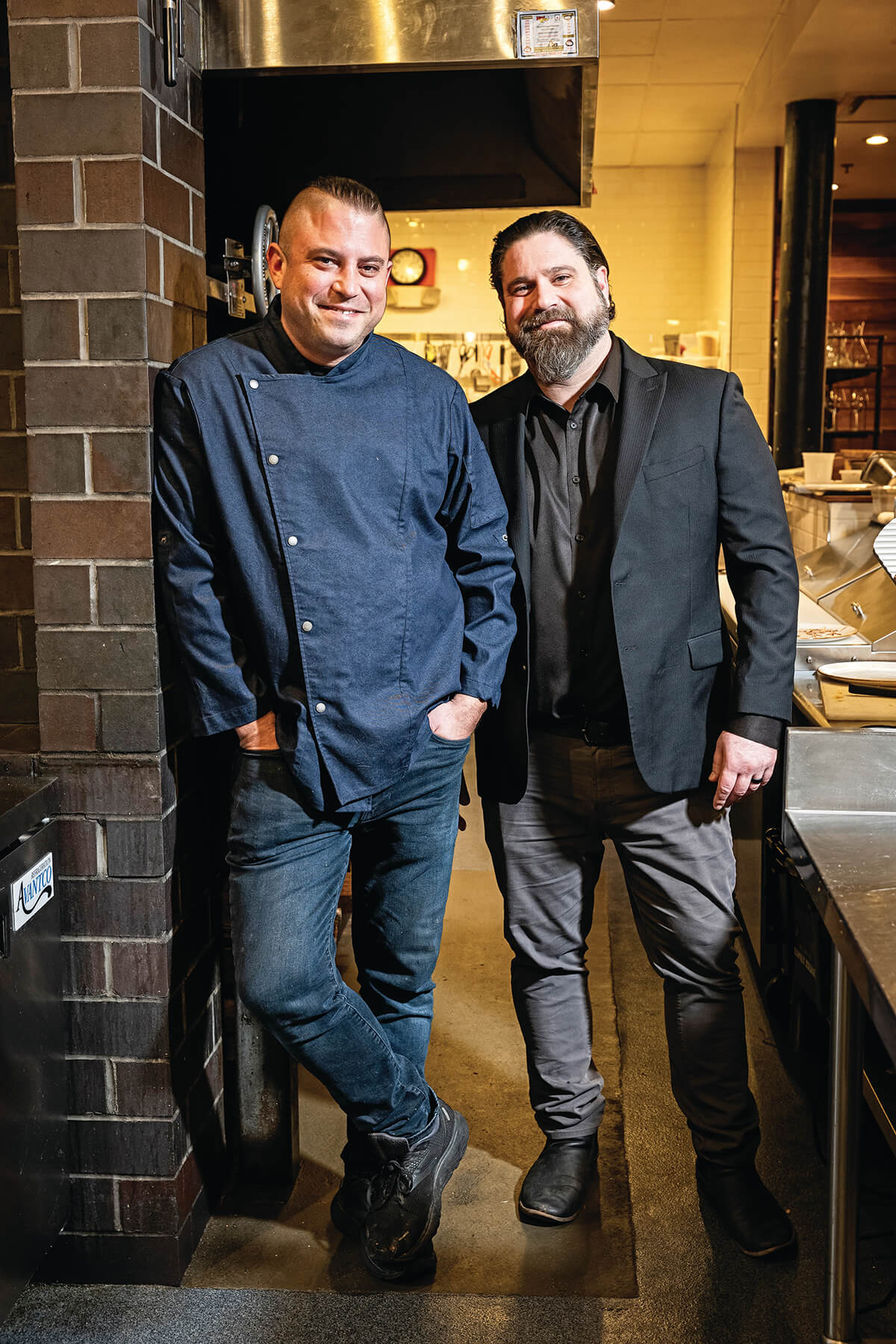
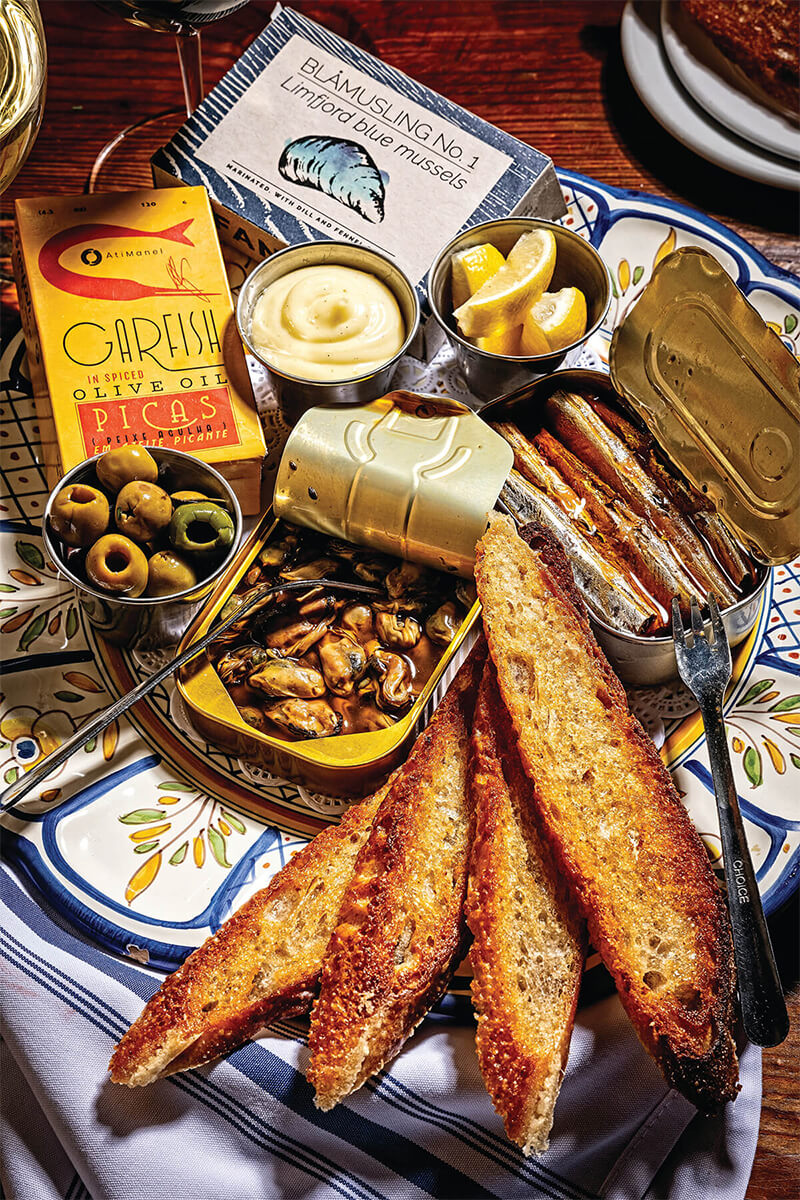
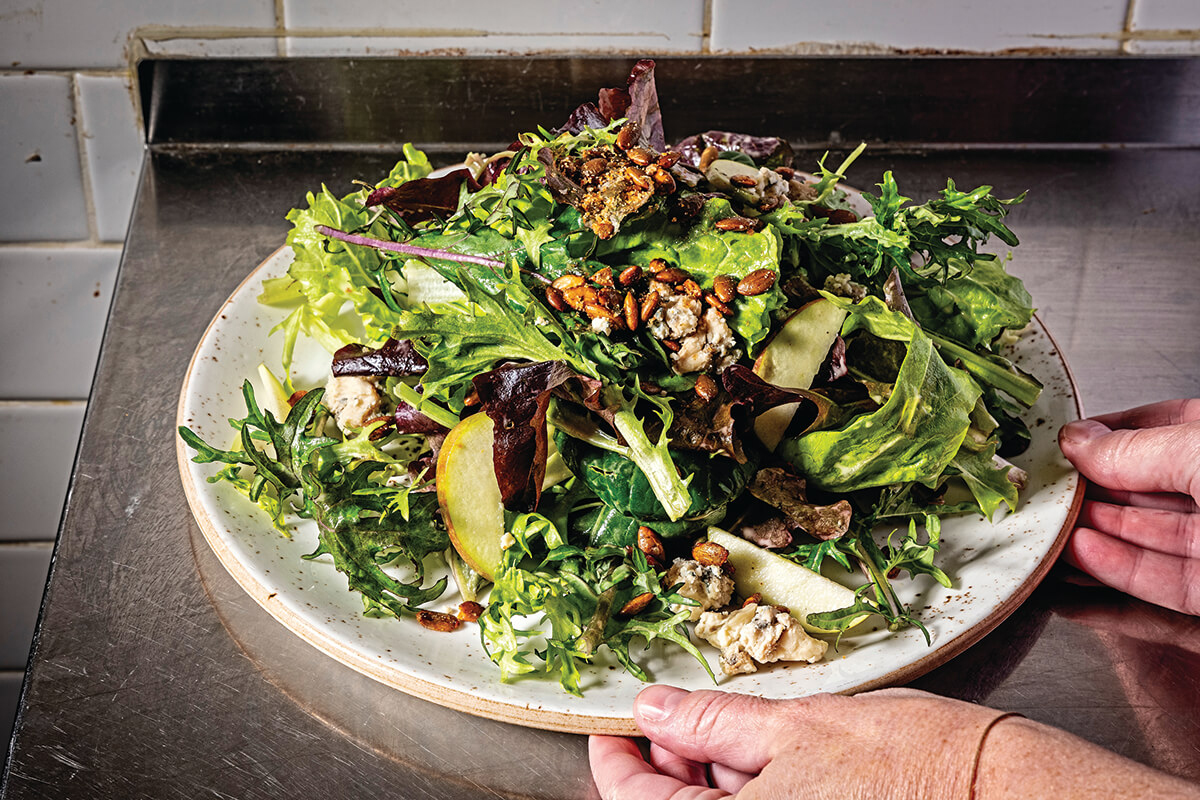
Clockwise from top: Shrimp a la plantxa; a variety of tinned fish; mesclun greens with sliced apples and crumbled La Peral; fresh baked bread; Chef Ben Lefenfeld and his co-owner brother, Jake.
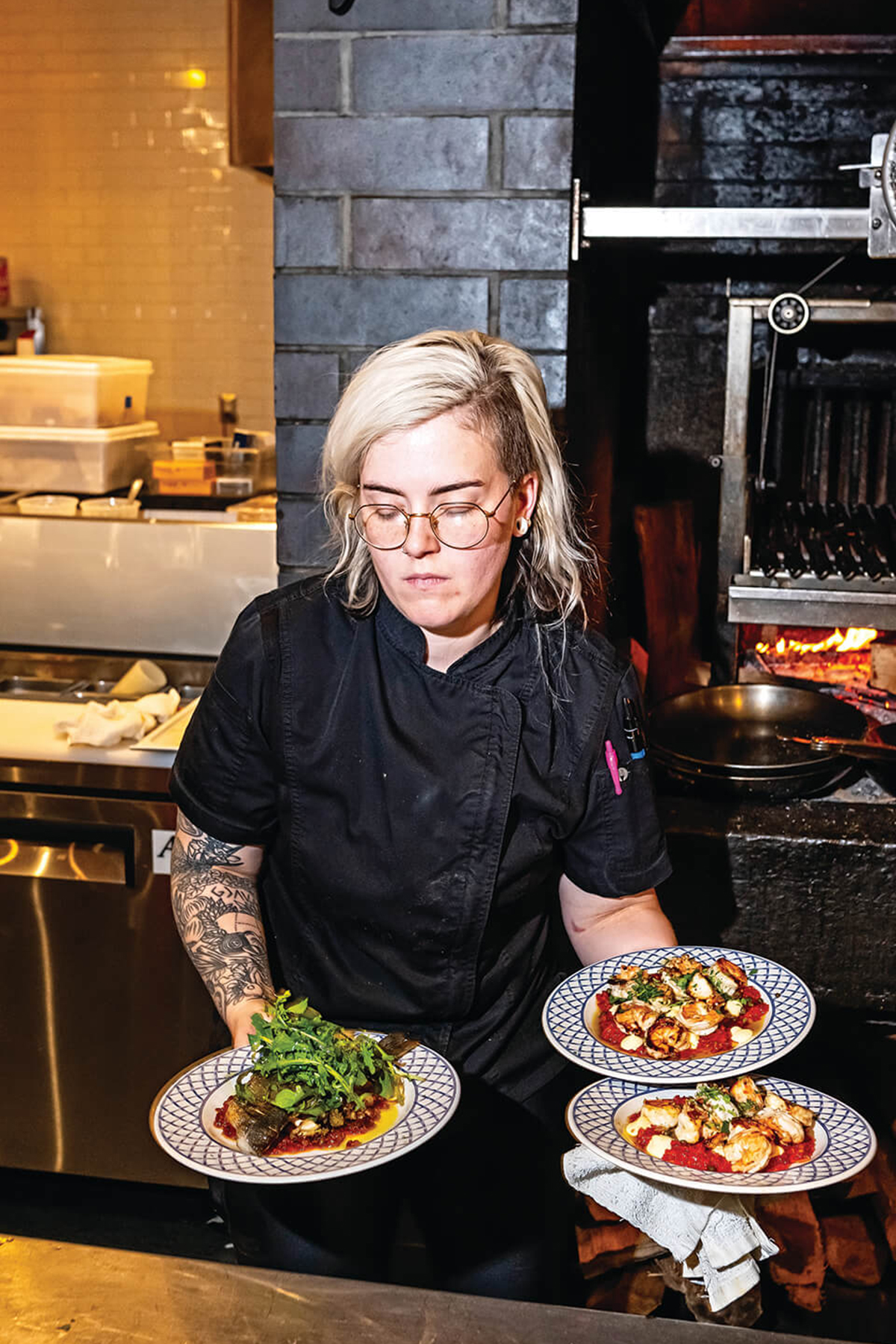
Gathering plates to serve.

his Basque-country restaurant inside historic Meadow Mill is a paradise for food worshippers. Like the region itself (known for its many Michelin-starred spots), a visit here feels like an endless feast combining classic ingredients with creative flavors. Whatever the season, co-owner/executive-chef Ben Lefenfeld’s ever-changing menu, inspired by this coastal region between France and Spain, is a thrill to peruse. Explore all the offerings, from an outstanding assortment of conservas (tinned fish) to the one-bite snacks known as pintxos (the chorizo with Manchego and shishito pepper is one of the best bites in Baltimore). Many of the bigger entrees—including a plate of wood-grilled eggplant with ricotta or strip steak with black-garlic butter—are prepared over the coals of the asador grill, which adds dimension with smoky flavor. The pristine seafood is always formidable, including the grilled shrimp and scallops with zucchini escabeche, fennel pollen, and aioli we devoured on one recent outing. Service is pleasingly dependable (special shout-out to veteran Aaron Loux, who makes it look effortless). And half-price wine night on Sundays with a bottle of the region’s famed Rioja is our favorite way to wind down the weekend.
La Scala Ristorante Italiano
LITTLE ITALY
Little Italy’s La Scala is as old-school as they come. The servers are dressed like steam-train conductors, the pepper grinders are brandished like wands, and the pasta—made in-house—is worthy of all those ancient ladies making orecchiette on Pasta Grannies. Chef-owner Nino Germano has been running the place for over a quarter-century, and it manages to be both traditional and idiosyncratic: There’s a bocce ball court near the front door, and instead of a chandelier, there’s a wooden octopus hanging from the ceiling. Whatever makes Germano happy is fine with us. There are splendid iterations of gnocchi and risotto and antipasta on offer, as there should be. The calamari fritti and veal scallopini are outstanding, as has been every plate of pasta we’ve ever ordered, particularly the Bolognese, puttanesca, and ethereal gamberi fra diavolo. Finish off with a demitasse of espresso and at least one order of tiramisu.
Le Comptoir Du Vin
STATION NORTH
Hidden away in a sliver of a rowhouse on a ramshackle Station North street, walking into Le Comptoir is like stumbling upon a sudden portal to Aix-en-Provence. Rosemary Liss and Will Mester have created a French-ish bistro and wine bar that feels at once upscale and familial, as if your Gallic grandparents had been secretly trained in the classics. Bottles of wine line the walls, the menu is chalked on a blackboard, and the dishes—ever-changing rustic takes on countryside food that are both unconventional and unexpected—come on mismatched china.
One night, there might be a cassoulet or a stew of lentils with goose liver. Another might yield tomato tarts or soup au pistou. An appetizer of rolled pig’s head, green sauce, and grilled bread is spectacular, as is the restaurant’s famous mussel toast with saffron aioli. If there aren’t enough of the tiny dinner tables, there’s a basement dining room that feels like a forgotten wine cellar and which turns into a patio during the warmer months. The bread is made in-house, the natural wine list is long, and the desserts (lemon posset!) are sublime.
Limoncello
LOCUST POINT
The menu at this contemporary Italian restaurant is attractive for many reasons. Let’s start with the food: Antipasti like the torta di melenzane, aka baby eggplant in tomato sauce topped with fresh mozzarella, are excellent, as is the bruschetta with fig jam, Gorgonzola, and 24-month aged prosciutto. Pasta dishes, like orecchiette with crumbled fennel sausage and roasted-garlic broccoli rabe, harken to Italy’s Campania region, where the owners have their roots. And entrees, like a plate of grilled shrimp, swordfish, calamari, and octopus with fingerling potatoes and an arugula-tomato salad, are caringly prepared.
Chef-co-owner Gennaro DiBenedetto allows the seafood to speak for itself while ensuring that its flavors are accented by the right level of char from the grill. But we also love the menu itself—literally. Its colors and fonts are festive, capturing how it feels to dine here. Located on the first floor of shiny Anthem House in Locust Point, the sprawling space is bright and lively, and the large bar has some of the most comfortable stools in town. Reservations fill up on the weekends, so plan ahead or risk disappointment.
Linwoods
OWINGS MILLS
Don’t come to this 36-year-old Owings Mills stalwart if you’re looking for newfangled trends or to fill your social media feed with images of salmon with edible gold leaf or chopped sandwiches—yes, those are both a thing. This white-linen spot—long the ad-hoc fine-dining room for Baltimore County—is all about quality and consistency, resulting in the kind of cooking you’ll want to enjoy with friends or family for a special occasion, or any reason at all. Whether you grab a seat at the bar to sip a pineapple martini and snack on shrimp scampi flatbread; choose to perch at the grill line, with its view of the open kitchen and garde mangers stacking salads in ring molds; or sit at a table for that piece of simply prepared fish that’s been on the menu since the beginning, all roads lead to perfection. The eponymous Linwood Dame, who last year sold the business to his longtime executive chef, Tom Devine, and Erena Vedensky, Linwoods’ chief financial officer, is no longer a nightly presence, but other familiar faces, like veteran staffer-turned-general-manager Stacey Taylor, prevail to table touch and make you feel oh so cared for.
Magdalena, A Maryland Bistro
MT. VERNON
If you want to impress out-of-towners or just want to get glitzed up for a night on the town, head to this epitome of elegance inside The Ivy Hotel. The posh dining rooms and Eden-like patio exude a quiet luxury, but after a post-pandemic relaunch, the bistro-style menu is a bit more approachable. The menu draws from the area’s best fishermen and farmers and leans into the seasons, while always paying its respect to the Mid-Atlantic. Each dish is executed with consistency and care, from a crispy sea bass with chanterelles, Sungold tomatoes, and turmeric oil in summer to a golden Amish chicken with pickled okra in the fall.The whiskey selection, the cocktails, and Wine Spectator-awarded bottle list make for ideal accompaniments.
We suggest going with a few friends for maximum sharing opportunities. Our own perfect Magdalena order includes a basket of house-made bread with ever-changing butters, the artisan cheese plate, and the heavenly dessert board including pastry chef Cassidy Lueck’s phenomenal ricotta doughnuts served with a scoop of seasonal ice cream. For the ultimate experience, splurge for a room upstairs (breakfast from the restaurant is included).

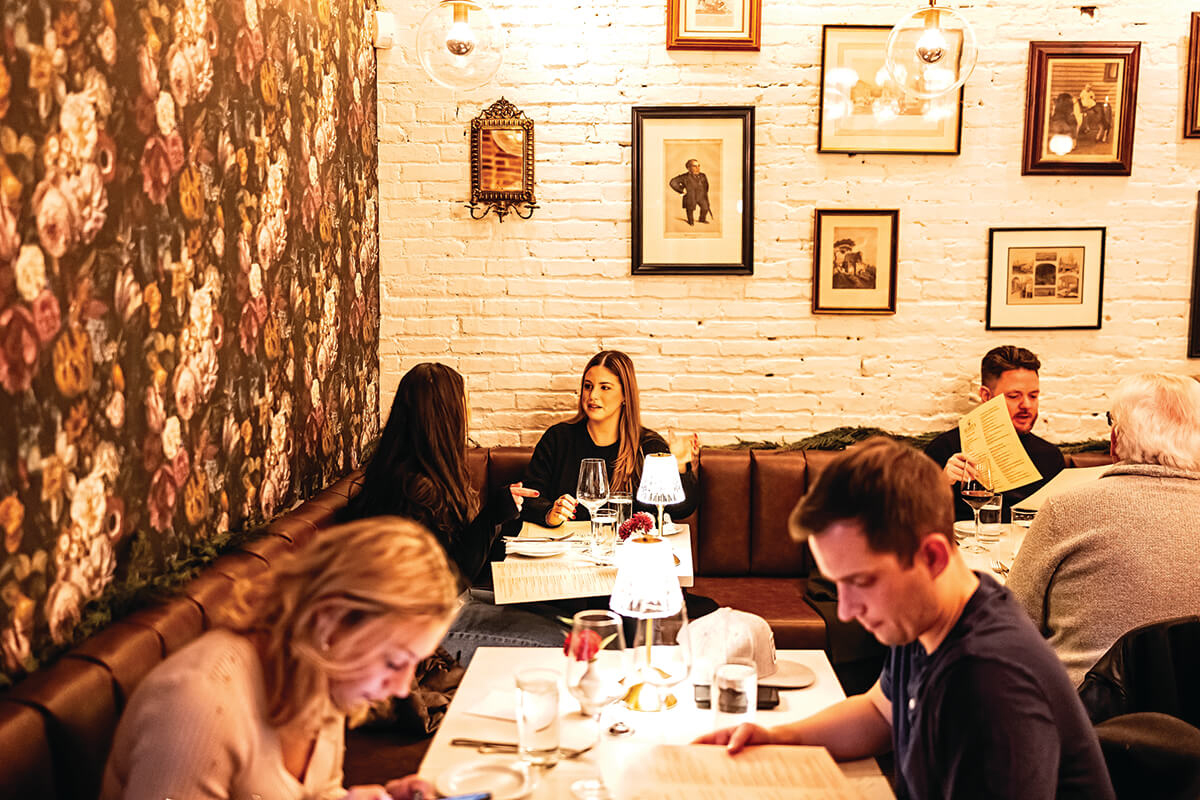
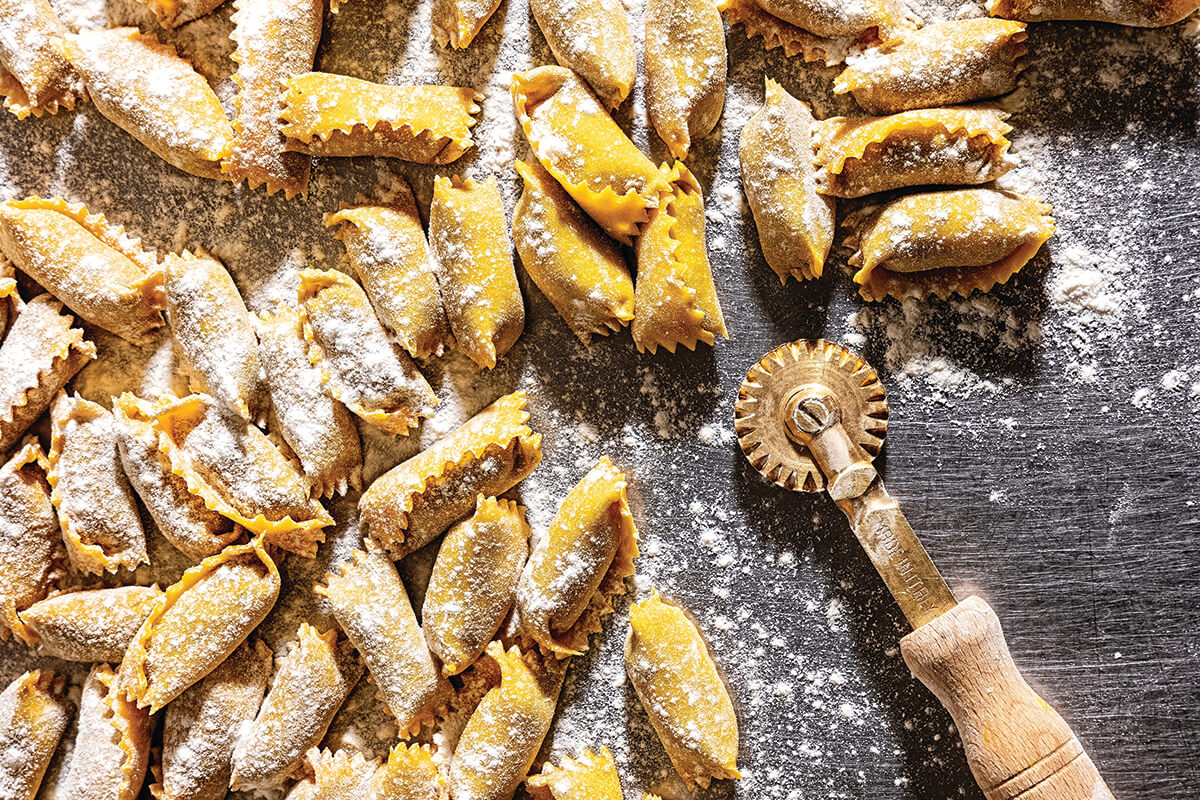
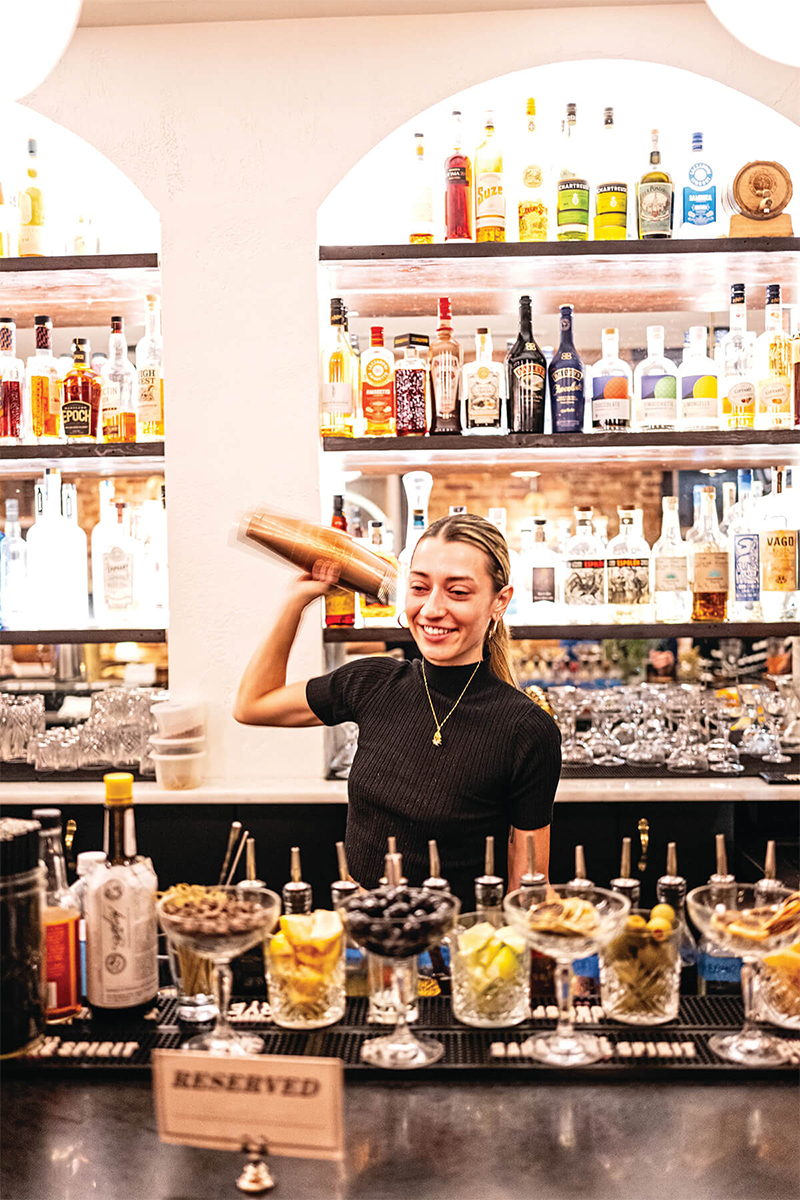
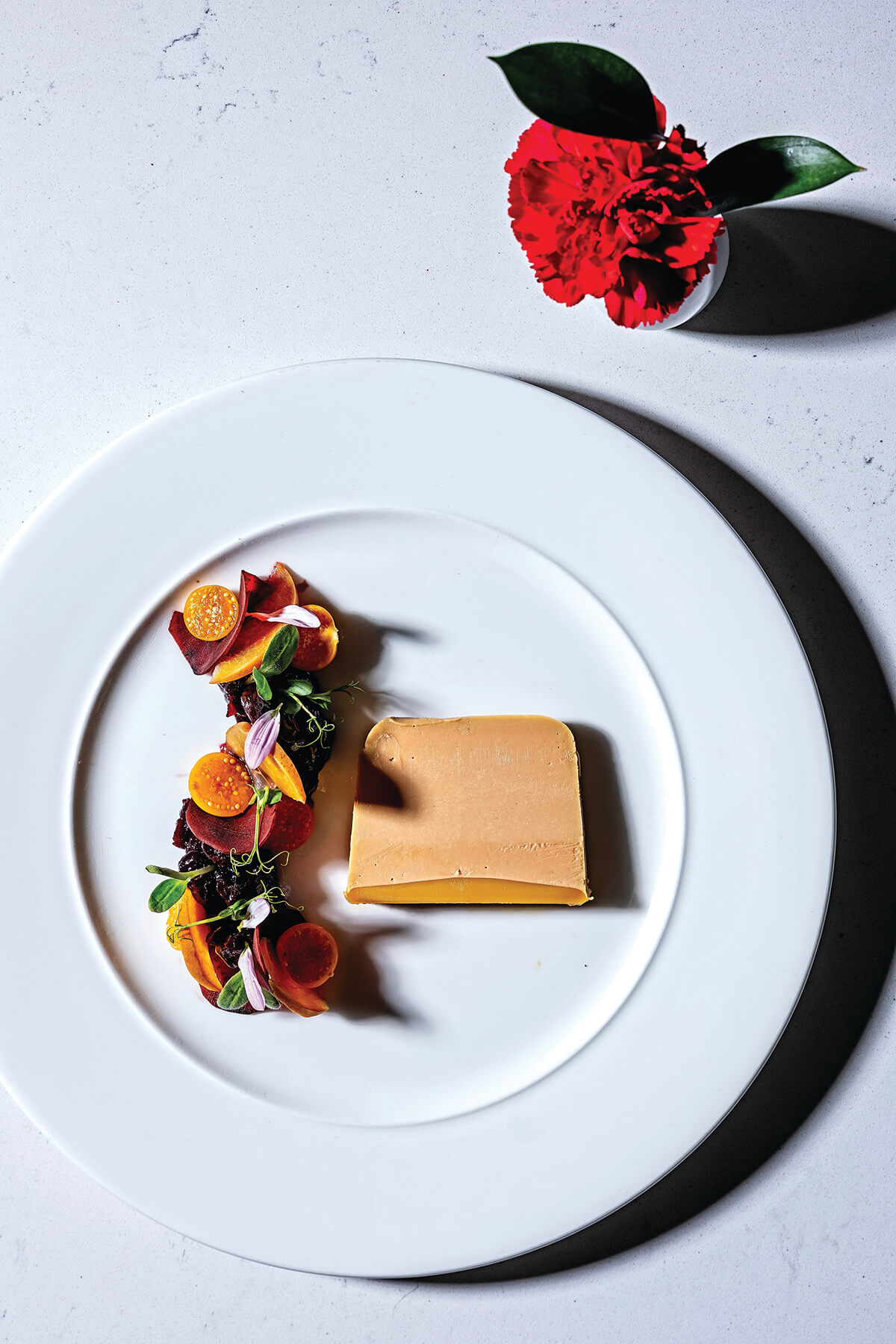
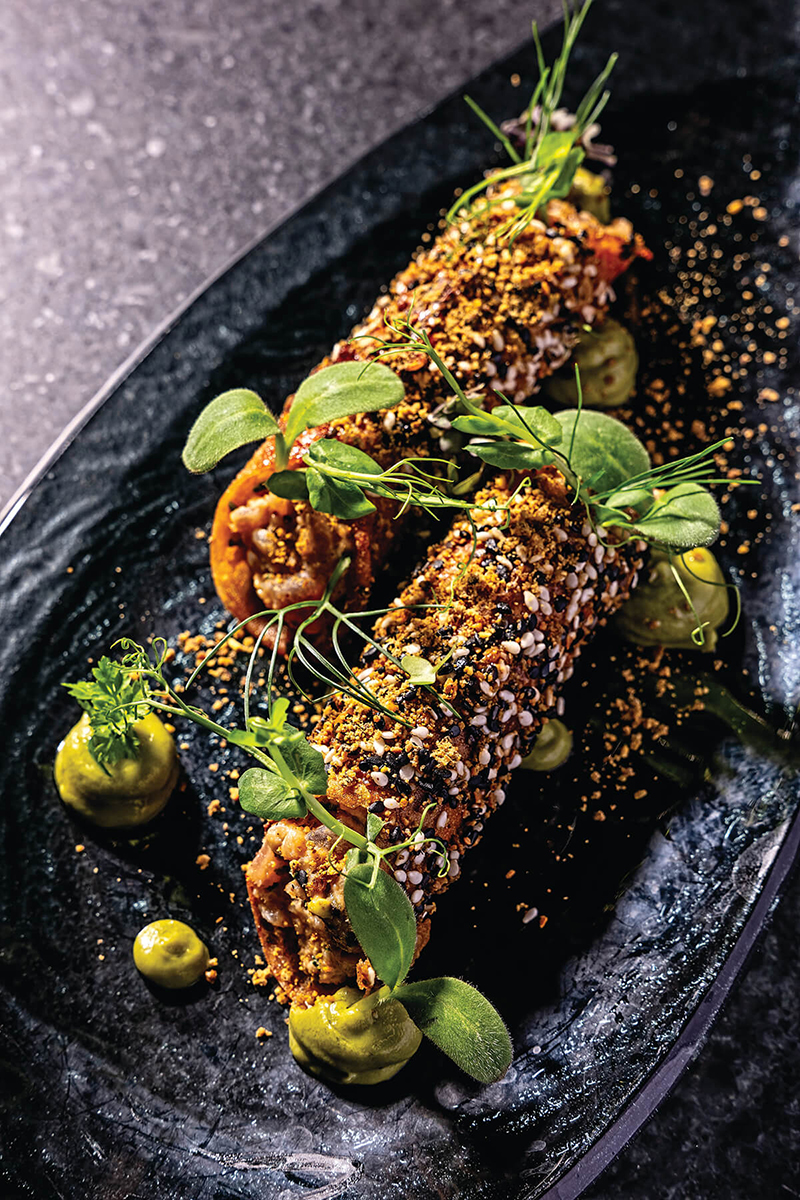
Clockwise from top: The dining room; house-made pasta; shaking a cocktail; the tuna cannoli; the foie gras terrine with pickled beets and sour cherry compote.
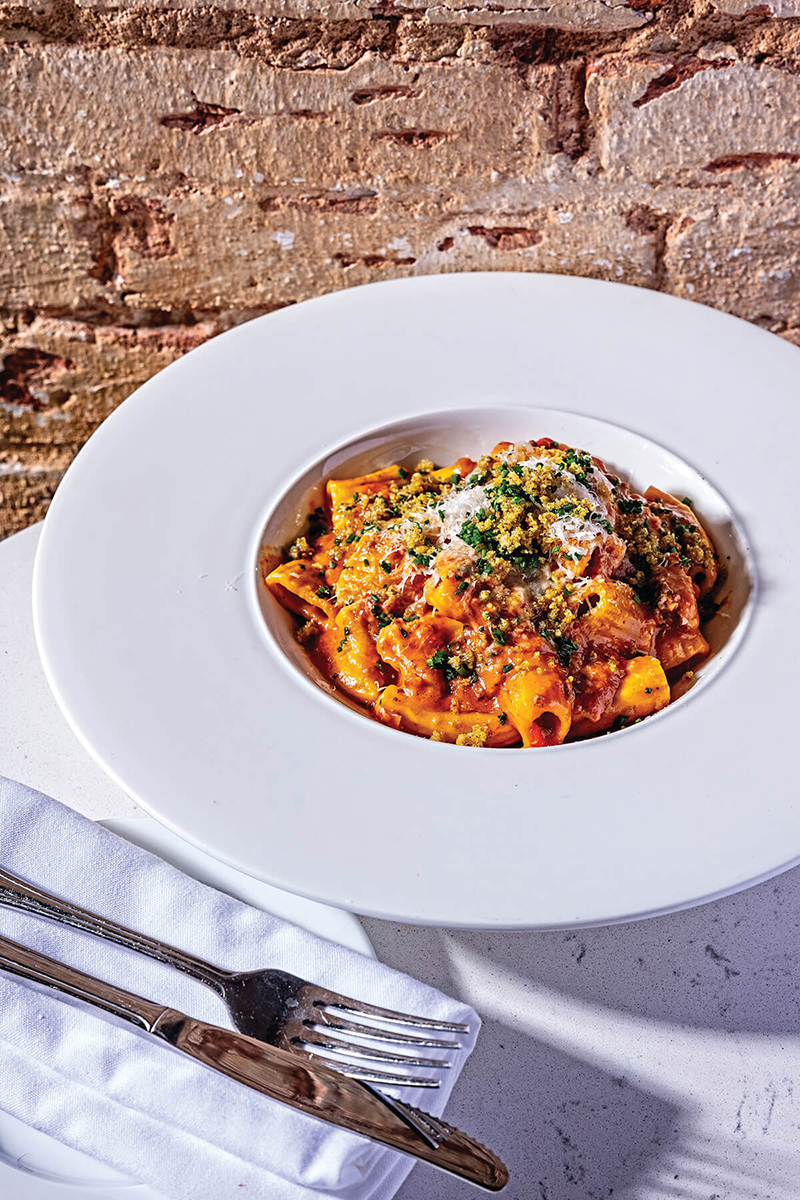
A bowl of ziti Bolognese.
This intimate Butchers Hill boîte—all aglow on East Pratt Street in the former Salt Tavern space—fires on all cylinders, from the food to the service to the vibe. Working in his compact kitchen, owner Matthew Oetting puts a polished spin on familiar Italian-leaning favorites, and his presentations result in some of the prettiest plates in the city. On one visit, that might mean a tangle of toothy house-made frutti di mare linguini splashed with white wine, teeming with clams, mussels, and scallops, and enrobed in uni butter. On another, it might mean an inventive scallop piccata tossed with artichokes and tomato-garlic sofrito, or a work-of-art tuna cannoli shell stuffed with yellowfin and dabs of avocado purée. The bar program offers four different types of negronis, a roster of amaros to help you digest, and wine by the glass that leads to some of the most generous pours around. The place gets packed and can get a little loud, but it’s always a good sign when you’re where everyone else wants a piece of the action, too.
The Milton Inn
SPARKS
Ever since its 2021 opening under the auspices of the Foreman Wolf Restaurant Group and chef-partner Chris Scanga (formerly of Petit Louis Bistro in Roland Park), this bucolic country haven, whose former claim to fame is that it was John Wilkes Booth’s one-time schoolhouse, only gets better and better. Over time, the menu has become more approachable, with less focus on game and more emphasis on the greatest hits from the Louis menu—the iconic crispy squash blossoms with saffron aioli, the Left Bank-leaning quiche Lorraine, the croque monsieur, and the best onion soup this side of the Seine. But there are plenty of items that are unique to the Inn, too, further highlighting Scanga’s mastery of French foundational cooking. The pan-roasted Scottish salmon in sorrel sauce is exemplary, as is a simple New York strip boosted by Béarnaise and the divine steak tartare complete with caviar and a quail egg.
There’s no such thing as a bad seat here—some rooms are bright and airy; others are dark and moody. The patio, replete with a fireplace, is perfect even when the air has a slight chill. Whatever the backdrop, the execution is on-point, the flavors are fantastic, and the hospitality is warm and sincere. Go on Wednesdays when wine is half price. And always visit the dog-themed bathroom near the bar, even if only for the selfie.
Nihao
CANTON
After briefly closing for a reboot last year, NiHao reopened with a new menu that put the Canton rowhouse restaurant more in line with chef-owner Peter Chang’s small empire of Mid-Atlantic restaurants highlighting traditional regional Chinese cuisine. NiHao’s kitchen now sends out plates of its superb signature Peking duck (a holdover from the previous iteration, as regulars would have revolted otherwise), plus huge bowls of flounder spiked with hot chiles or Sichuan peppercorns and cabbage, both takes on the classic water-boiled fish, as well as crispy popcorn chicken laced with bright red chiles—not to mention an impressive list of dim sum. NiHao also features more than a dozen baijiu cocktails, made with the national spirit of China, traditionally distilled from sorghum, which makes for a great addition to the local mixology scene. Be sure to order the xiaolongbao (soup dumplings) steamed in bamboo trays, or the crispy, doughy balloon of bubble pancake that is another of Chang’s signatures. It’s a great, showy start to what is a banquet of a meal.

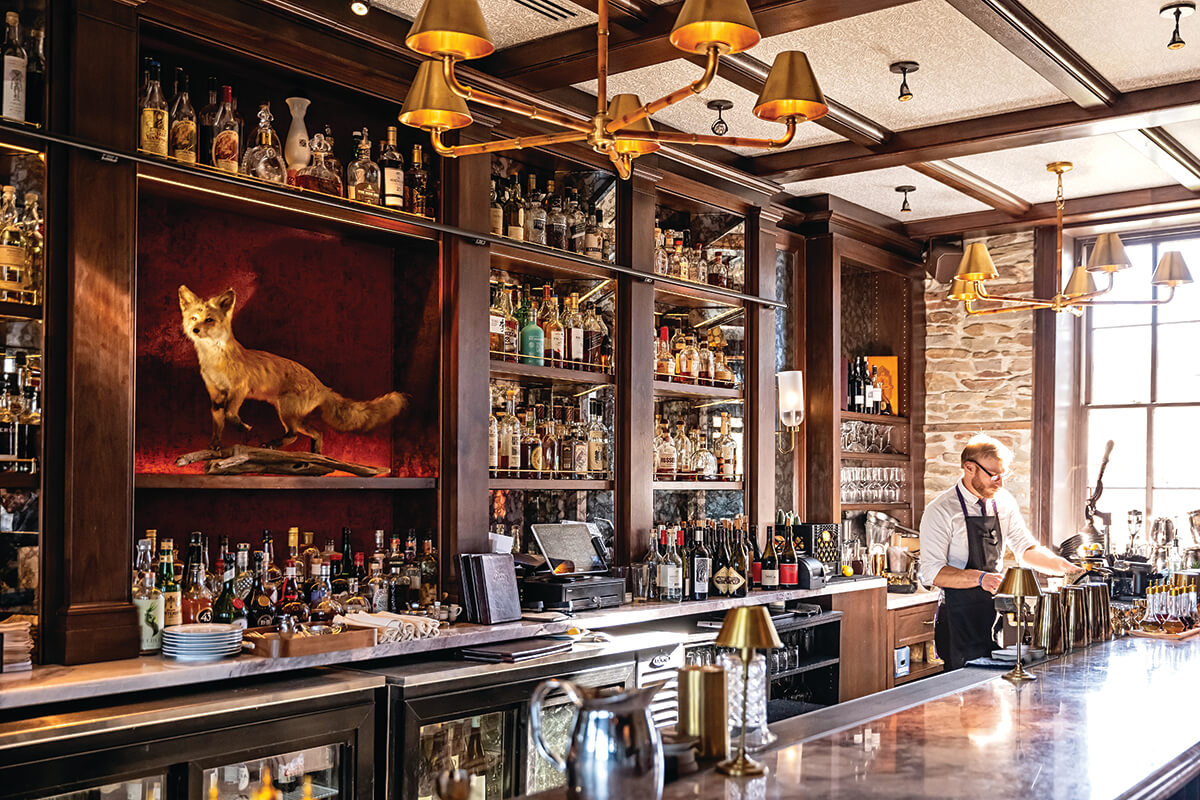
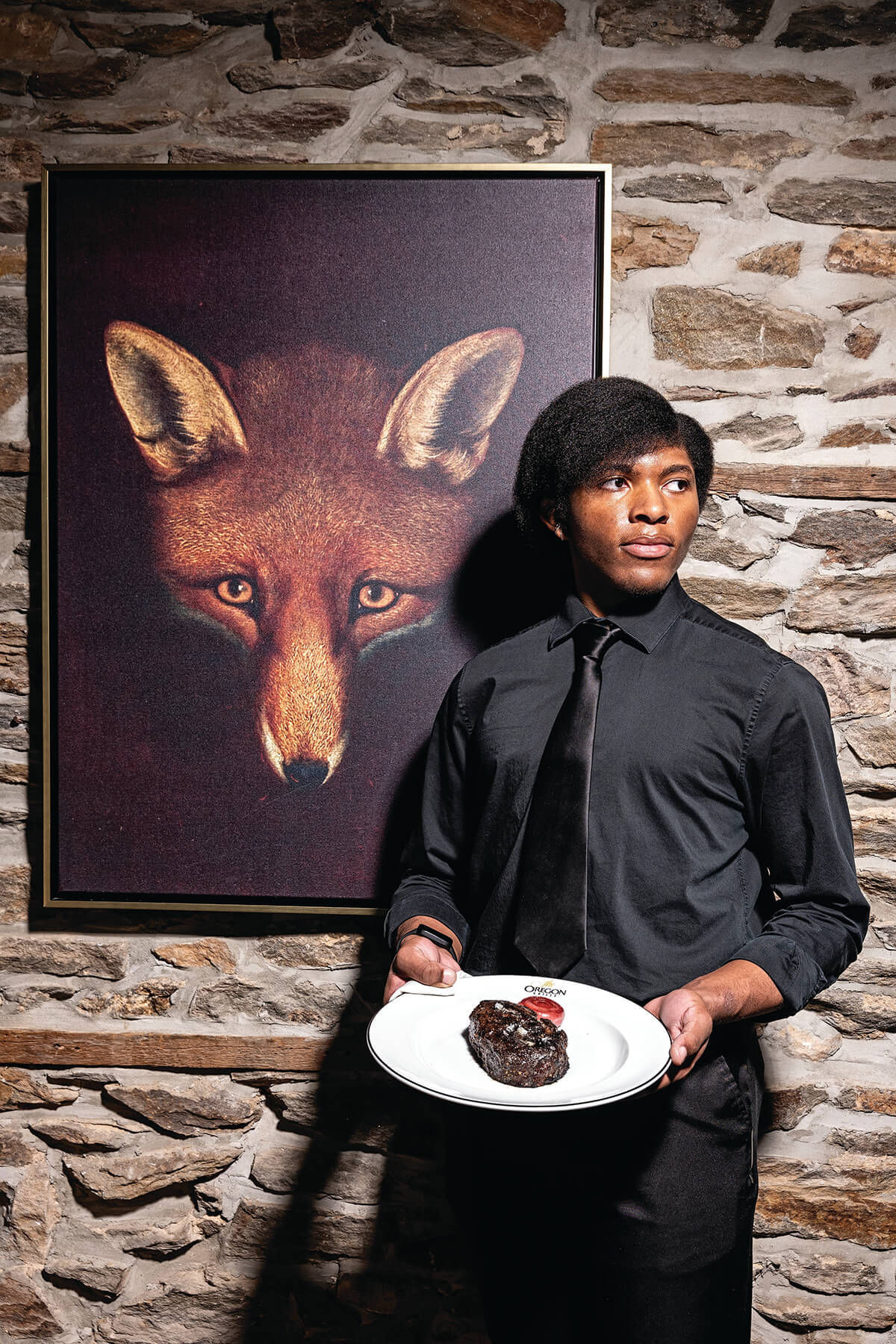
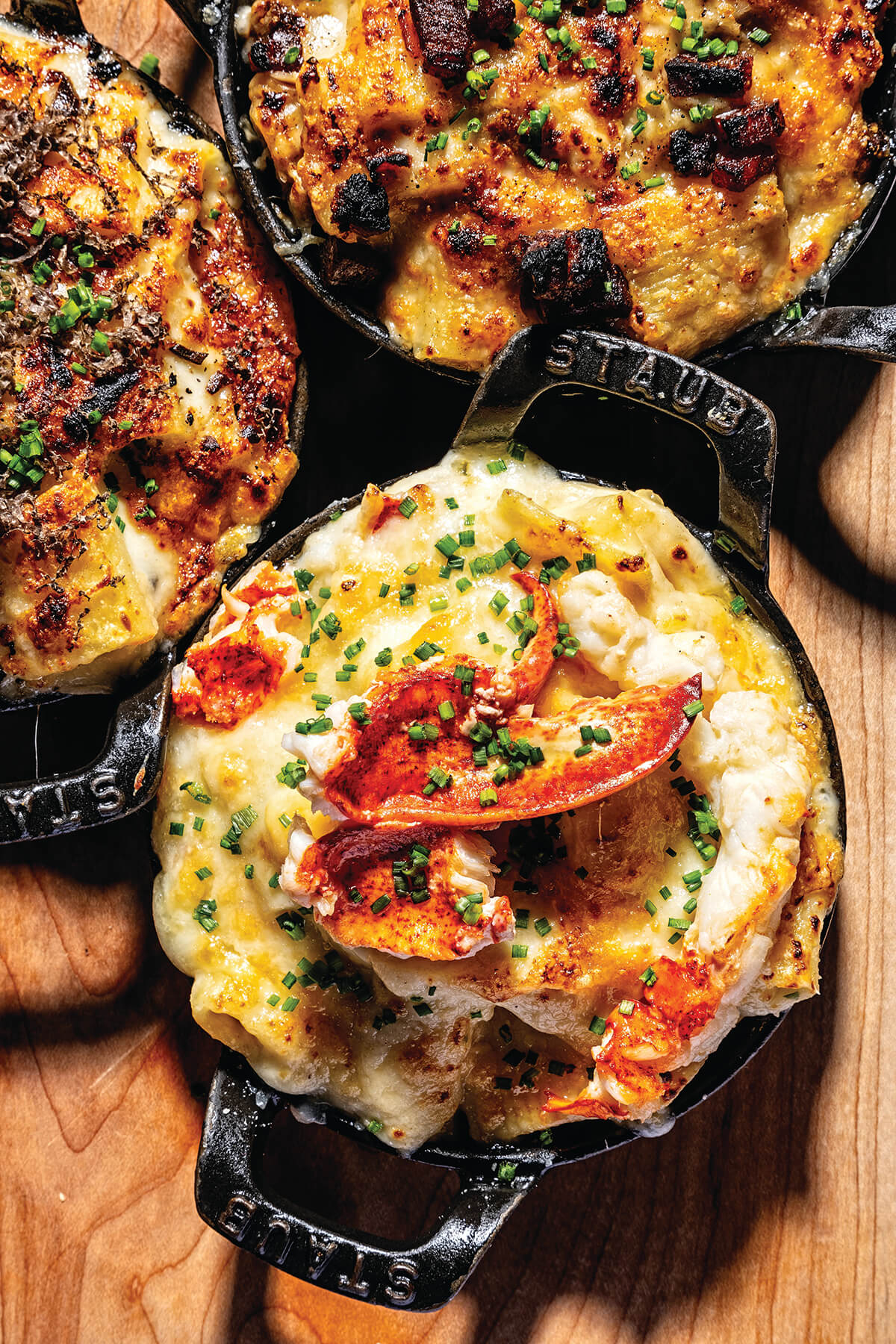
Clockwise from top: The scene at the bar; mac and cheese with a lobster tail; a server holding the bison rib-eye.
It’s risky business taking a scalpel to a legend, but after 25 years as a go-to destination for Baltimore County diners, The Oregon Grille needed some work. Its menu had grown predictable and its appearance stale. Enter the Atlas Restaurant Group, which reopened the restaurant last year after a multi-million-dollar renovation. Thankfully, with its dark wood tones and some of the old horse saddles still on display, the space retained its rustic elegance and clubby vibe.
Plenty of interesting dishes now permeate the menu, including a potato skin-caviar appetizer and roasted beet-burrata salad with arugula, candied pistachios, tangerines, and a honey vinaigrette. But rarely have we left a restaurant raving about a specific dish like we did after devouring the bison rib-eye. The 14-ounce star of the show emerged from the kitchen with a deep char yet juicy red interior. Bison is leaner than beef, which is why we were so impressed by its deep flavor. As the fireplace crackled and a piano player tapped away on the keys, we were reminded that while The Oregon Grille has a storied past, it’s now writing an exciting new chapter.
Peerce’s
PHOENIX
This jewel box of an Indian restaurant, nestled along Dulaney Valley Road, is a beacon from a dark stretch of country road. As you step onto the patio, you’ll find yourself in a verdant Eden overflowing with greenery and a trellis entangled with vines. The interior of the restaurant—think dramatic, curry-scented dining rooms that flicker with candlelight—is equally elegant. Co-owner brothers Binda and Keir Singh of Howard County’s Ananda explore their roots in Punjabi cooking with traditional yet modern interpretations of always well-seasoned dishes like tandoori chicken, fish curry, garam masala goat, and lamb vindaloo. And their vegetable-based offerings, from spiced okra with onions to eggplant curry, crush the concept that vegetarian fare is boring.
The expansive menu also bends with the seasons and nods to Maryland, as evidenced by the crab khumbi with sweet meat tucked into a portobello mushroom capped with coconut chutney. And as anyone who has ever been to Peerce’s knows, no visit is complete without at least a passing conversation with the sartorially suited Keir, who sets the tone with his genuine warmth and is always on hand to make a recommendation. (Ask him about the off-menu butter chicken if you like a lot of heat.)
Peter’s Inn
FELLS POINT
Whenever we have new guests in town, there’s always one place we take them for the most culinarily quintessential introduction to Charm City. Somehow both gritty and quietly cosmopolitan, eccentric yet accessible, this former Ann Street biker bar manages to capture all the wonderful contradictions of our underdog town. Only owners Karin and Bud Tiffany could combine a sidecar-ed martini served on a silver platter with a stereo cranking out The Clash. Or a just-right New York strip steak with a giant taxidermied marlin above the bar. Or Prince Edward Island oysters (with a “bump” of caviar, no less) and the best Texas toast-style garlic bread you’ve ever had.
Hand-written menus mingle with antique oil paintings and the oohs and aahs of both longtime loyal patrons and wide-eyed come-latelys. That’s because Peter’s is the inimitable blend of no-fuss and plenty of frills, with each dish having its own magic touch. On a recent visit, our pasta al limone arrived with an unexpected punch of buttery sautéed shrimp, smashed pistachios, and smoky chile flakes. It’s a sin to skip the surprisingly lovely house salad, decadent smoked trout pâté, or divine pot de crème dessert. And those relatively new French fries rival McDonald’s, which we mean as the highest possible praise.
Preserve
ANNAPOLIS
Occasionally we find ourselves in Annapolis in search of supper, and more often than not, that means we’ll make our way up Main Street to this now-mainstay on the state capital’s most bustling strip. Amidst the throngs of white-hatted Navy plebes and across from the bright lights of Chick & Ruth’s Delly, Preserve is easy to miss, though once you’ve had a bite inside, you won’t soon forget it. Since 2015, husband-and-wife team Jeremy and Michelle Hoffman—formerly of Thomas Keller’s Per Se and Danny Meyer’s Union Square Café, respectively—have been turning out some of the most ambitious food in Anne Arundel County.
Much is in the name here, with the chef’s Pennsylvania Dutch heritage melding with the ingredients of the Chesapeake and pickled and preserved elements dotting the boundary-pushing menu. Fried duck tongues with rice vinegar aioli and chile crisp were an appetizer we never knew we needed, while the pork terrine is a perennial star, especially the version with fennelpeach kraut and Dijonnaise on offer last summer. Always indulge in the daily specials, inspired by provisions from the restaurant’s roster of local farmers, and on that note, consider a bottle from Old Westminster Winery, made just up the road.
Puerto 511
DOWNTOWN
Open since 2014 and reworked in 2019 with a prix-fixe-only menu, Puerto 511 is a hidden gem tucked away off a side street in the heart of downtown. Open the door to what feels like a secret gateway to Lima, and you’ll find Peruvian chef-owner Jose Victorio Alarcon’s minimalist dining room, with 10 small tables next to a tiny open kitchen. There’s lovely artwork on the walls and a steep staircase down to a beautiful dining room for larger parties, with a fireplace to boot. With five courses on weekdays and seven during weekends, Alarcon’s menu is a perfectly orchestrated series of dishes—all sized and paced just right—like shrimp in sweet chile sauce atop a corn tamal; grilled veal skewers over Peruvian corn and potatoes with pepper sauce; and a stunning dish of fish ceviche with sweet potatoes in tiger’s milk, a regional marinade of yellow peppers and lime. Puerto 511 is BYOB, which allows for personalization, but they also offer pisco sours, the traditional Peruvian cocktail—and a stellar accompaniment to Alarcon’s glorious food.
Restaurante Tio Pepe
MT. VERNON
This subterranean Spanish stalwart on the quiet edge of Franklin Street isn’t the hot spot it used to be. In fact, on a recent Tuesday night, we were the only table in the place, but before long, that felt like being in on one of Baltimore’s best-kept secrets. Two servers swept through with glasses of potent house-made sangria and the sort of old-world service that M.F.K. Fisher would praise. By the time other locals trickled into the cavernous dining room—dimly lit, decked in white tablecloths, dripping with oil paintings, and the occasional lipstick-red carnation—we were too busy swooning over the luscious garlic soup off the special’s menu (which hasn’t changed in a decade) to pay them any mind.
With minute steaks and stringbean almondines, the menu is stuck in 1968, the year that Tio Pepe opened, but that makes it kinda cool again. Start with the hollandaise artichokes and Serrano ham with melon. Then, while it might sound sacrilege, forgo the famous paella for near-perfection soft-shell crabs with lemon and butter and, always, the masterpiece suckling pig with pan jus, smoky black beans, and cinnamon-scented apple sauce that you’ll be dreaming about for days. But before you head back out into the modern-day night, find room for a café Americano and slice of the delightful pine nut roll for dessert. Turns out, they kind of knew how to live 56 years ago.
Tagliata
HARBOR EAST
This Italian Harbor East hot spot is the juggernaut of the Atlas Restaurant Group, which has 25 area restaurants (and counting). The vibe is swank—from the oversized card-stock menu (good riddance, QR codes!) to the sophisticated dining room to a lineup of deeply delectable dishes, thanks to co-owner-chef Julian Marucci, who coaxes big flavors from simple ingredients. All the offerings are excellent here, but be sure to order at least one of the house-made pastas stuffed or coated with all sorts of scrumptious items from rabbit to crab with uni cream.
The rest of the menu is a hit parade, too—some signatures with timeless preparations, like the beef tenderloin with spicy black garlic mostarda, others seasonal, like the smoked carrots with ricotta and truffle honey or risotto with roasted corn and crab. Pair it all with a pick from the seemingly limitless selection of award-winning wines, from Piedmont to Puglia. At the end of the meal, lounge on the patio or in the piano lounge over an espresso martini while taking in the spectacle of decked-out patrons passing by. La dolce vita, indeed.
Tapas Teatro
STATION NORTH
Like a classic film, this beloved Spanish restaurant is as relevant today as it was when it debuted 23 years ago in Station North. Adjacent to the Charles Theatre, it still draws moviegoers who down pitchers of the signature sangria (which can be brought inside the cinema). Everyone else seems to love it as well. The bar, dining room, and streetside tables are packed, but the staff remains friendly and unflappable. On a recent visit, we heeded our server’s advice and started with a handful of small plates. All were excellent, but the huevos de cordoniz y chorizo—strips of sausage topped with a rich quail egg on toasted crostini—stood out. After four, we wanted more. Along with the description for gambas al ajillo—shrimp sautéed in olive oil with garlic and parsley—comes a parenthetical: “Add capers or/and chiles for a kick.” To which we say, do both—it takes an already outstanding dish and turns it into a masterpiece. Like most movies, many restaurants fade over time. Only the greats endure.
Thames Street Oyster House
FELLS POINT
It seems like every hip restaurant has a raw bar these days, but well before freshly shucked seafood found itself in the Roaring Twenties-esque revival, there was Thames Street on its cobblestone namesake in Fells Point. For over a decade, owner Candace Beattie and executive chef-partner Eric Houseknecht have helped remind our city about oysters, the shellfish which once reigned supreme along the nearby waterfront long before crab was ever king. And here, in this Chesapeake-meets-New England eatery, those half-shells are served as impeccably as they come.
This is the place for even the least bold to try their first oyster. Your server will guide you from the accessible to the challenging. But the rest of the menu shouldn’t be missed either. The buttery whole-belly clam roll—with fat fried bits of bliss tumbling over the edge of a griddled split-top bun so good we’d eat it solo—would make our last meal. For sharing, a splurge for the five-pound lobster—stuffed with blue crab, shrimp, and scallops—is worth it, though the claw-knuckle-and-tail-packed polenta with English peas, mushrooms, and spring onions makes an ideal and still indulgent substitute. Funnily enough, we get especially jazzed about the seasonal sides, which on one late summer visit included the loveliest brown sugar baked lima beans we’ve ever seen.
The Tilted Row
BOLTON HILL
Executive chef Amy Hessel and owner Ziad Maalouf have created a destination-worthy restaurant on the ground floor of a modernist Bolton Hill apartment complex, with a menu of Middle Eastern dishes with a Maryland twist. Sit at the counter and watch the crew making plates of falafel-encrusted salmon, charred octopus with black-garlic aioli, or lamb kofta with hummus and preserved lemons. There is an excellent Sunday brunch (massive cinnamon rolls! crab Benedict!) and Blue-Plate specials like the fried chicken and biscuits that draws locals on Thursdays with dedicated regularity. Close to Maryland Institute College of Art, there’s a deceptive casualness to The Tilted Row that makes diners feel comfortable, yet the exceptional service, beautifully run open kitchen, and pretty plating elevate the place to fine-dining status. Be sure to order the za’atar focaccia, or the desserts—one regular often just orders the brown-butter toffee cake—as Hessel was also trained in pastry.

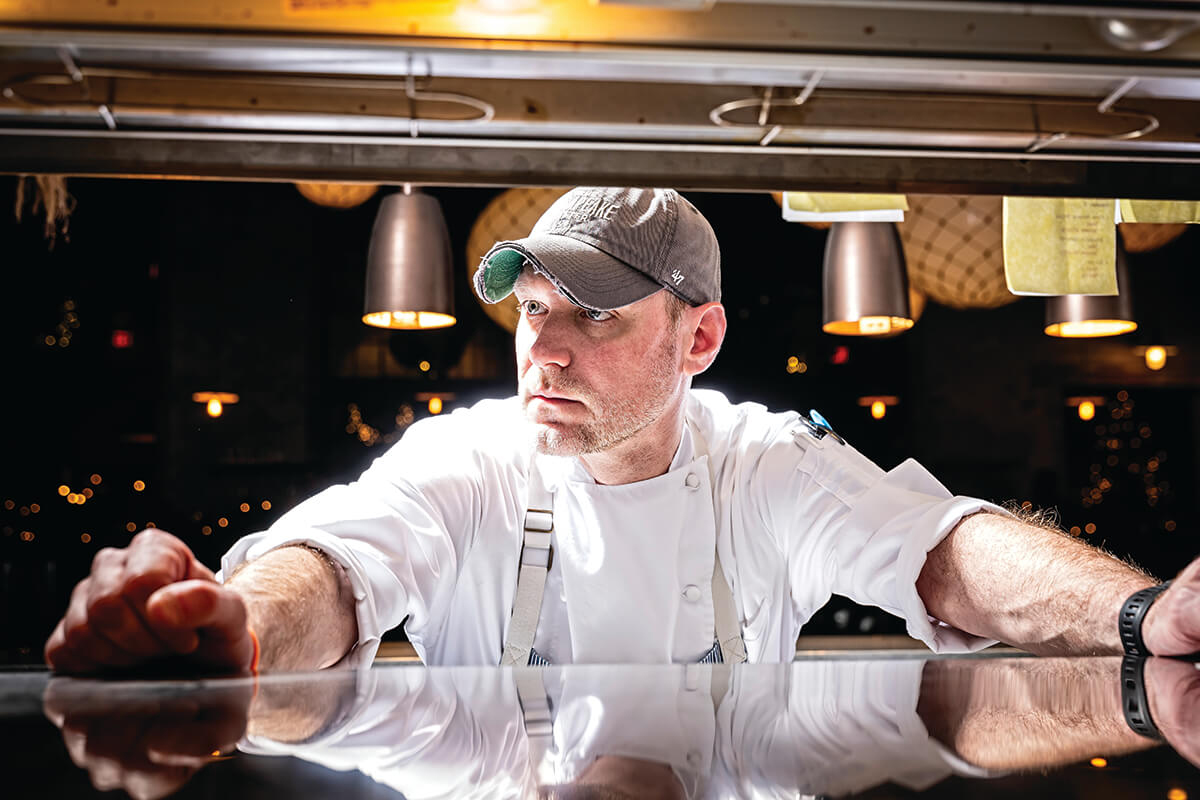
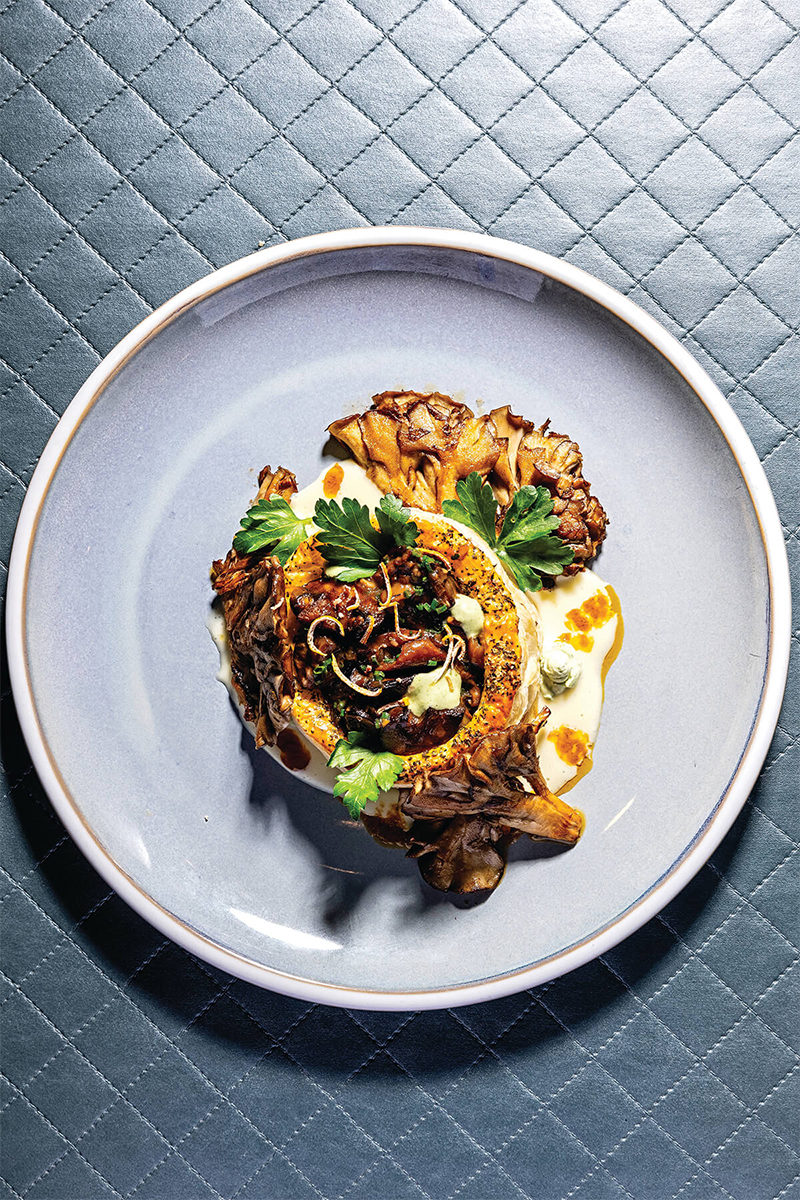
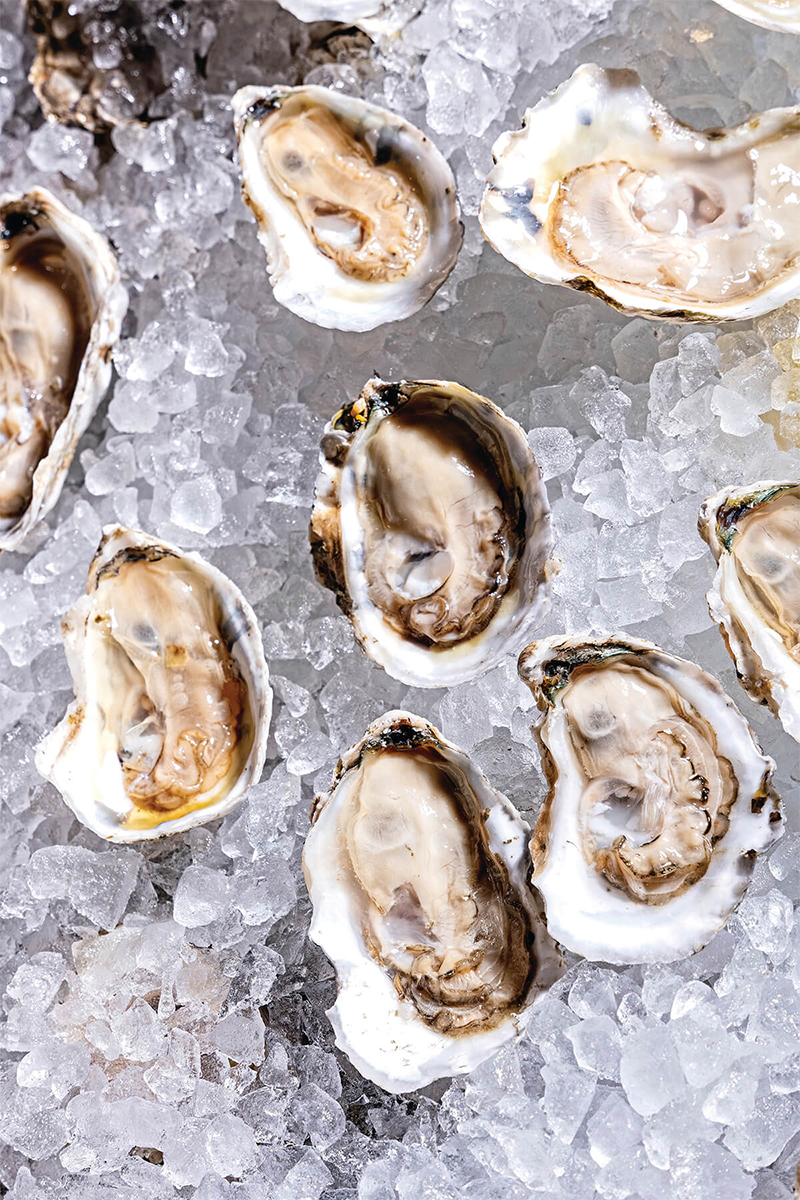
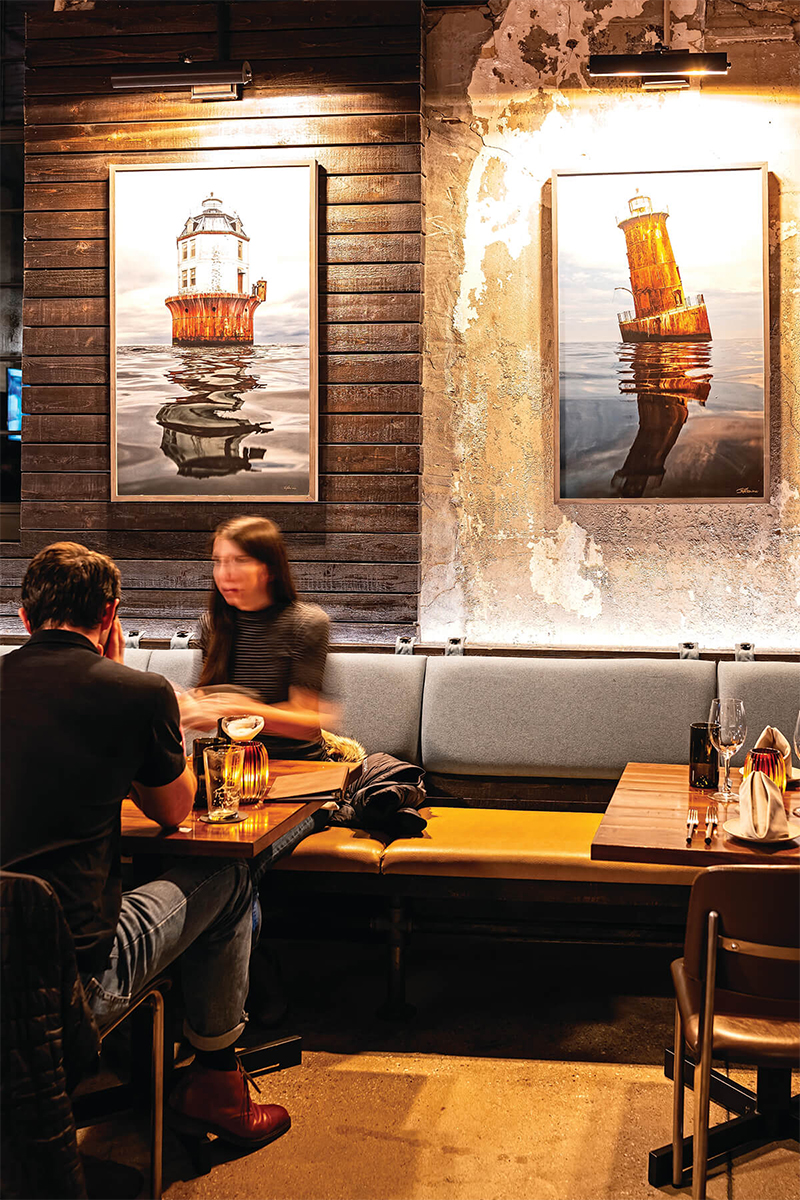
Clockwise from top: Chef Zack Mills on the line; the interior with nautical art; raw oysters on ice; the mushroom tart.
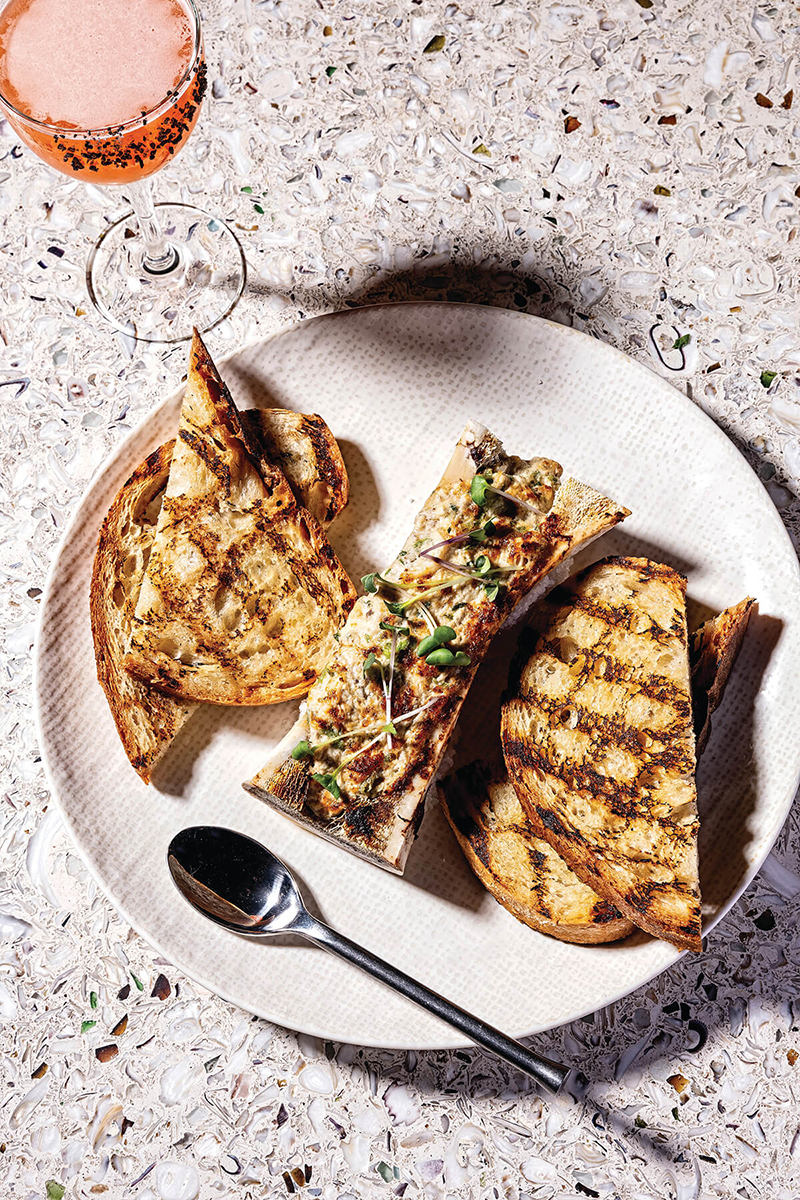
Blue crab and bone marrow.

et inside the historic, circa-1798 Whitehall Mill, True Chesapeake is a lofty, industrial setting for sophisticated Chesapeake cuisine. Most of the menu highlights hail from the raw bar, befitting a restaurant with its own local oyster farm, on St. Jerome Creek in Southern Maryland. Those oysters come a variety of ways: shucked, roasted, and topped with Old Bay and butter or Gruyére and black truffles; in dishes like oysters Rockefeller and oyster stew; or fried with cucumber noodles, pickled jalapeño, and puréed fennel. Of course, chef Zack Mills’ menu offers more than just oysters: There’s a silken spaghetti with middleneck clams; an elegant mushroom tart that looks like a beautiful bird’s nest built from pastry crust and filled with local funghi; and a spectacular blue crab and bone marrow dip, served in the bones. The cocktail list, made at the centerpiece bar embedded with crushed oyster shells, of course, is a finely tuned accompaniment for any dish. And the weekday happy hour for $6 martinis, Old-Fashioneds, and daquiris makes us, well, happy indeed.
Verde
CANTON
Long before gourmet pizza (including gluten-free and vegan) became a thing on menus across Maryland, there were blistered Neapolitan wonder wheels at this convivial hangout with Edison bulbs, marble accents, house-made fior di latte mozzarella, and a wood-fire pizza oven that turns out pizzas with pizzazz. You’d be hard-pressed to find pizza with more personality—Verde’s feature pairings such as prosciutto and fig, smoked mozzarella and lemon, and mushrooms with truffle cream. (And whichever one you pick, make a mental note to come back and try a different one next time.) But the toppings are only part of the equation. We also love the thin crust with its perfectly charred cornicione (outer edge), slight chewiness, and tangy topping of cheese. The menu is rounded out with excellent offerings from the bar (here’s looking at you, negronis!) and an array of outstanding antipasti—we constantly crave the puttanesca-style shrimp—that make this so much more than a neighborhood pizza joint.
Woodberry Tavern
HAMPDEN-WOODBERRY
We’ll admit that it took us some time to adjust when the restaurant once known as Woodberry Kitchen reopened as a tavern after the pandemic. But now that the place has found its footing, we can see that, though James Beard Award-winning chef Spike Gjerde’s original iteration was inarguably ambitious, the tavern is a more understated expression that’s no less charming. With its Windsor chairs, Persian carpets, and nostalgic desserts, the restaurant’s farm-to-fork DNA is still very much in place, with a focus on regional specialties that are at once familiar and novel.
As ever, almost all ingredients are sourced locally and dishes change with the seasons, but the experience is now more intimate. Executive chef Steven Kenny (a veteran staffer who worked at Easton’s famed Bartlett Pear Inn) is laser-focused on what’s available on any given day, but devises dishes that are as pioneering as ever. In early fall, that might mean “crab service” (a trio of dishes including crab salad, a crab pot, and crab fritters) or tortellini with chanterelles and sweet corn. In the colder months, you might find a pretzel-crusted pork loin with miso-buttered cabbage. When the mercury dips, oysters three ways emerges, including fried, roasted, and raw. The pretty-as-a-picture baked Alaska is iconic. Turns out, you can go home again, especially after a total reinvention.







